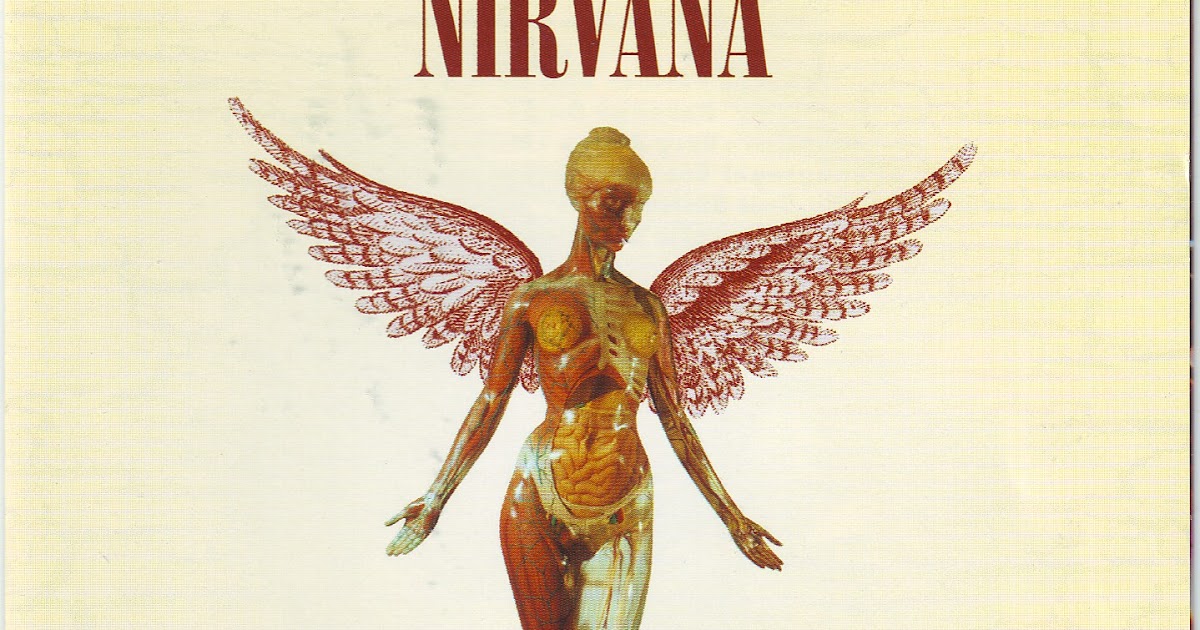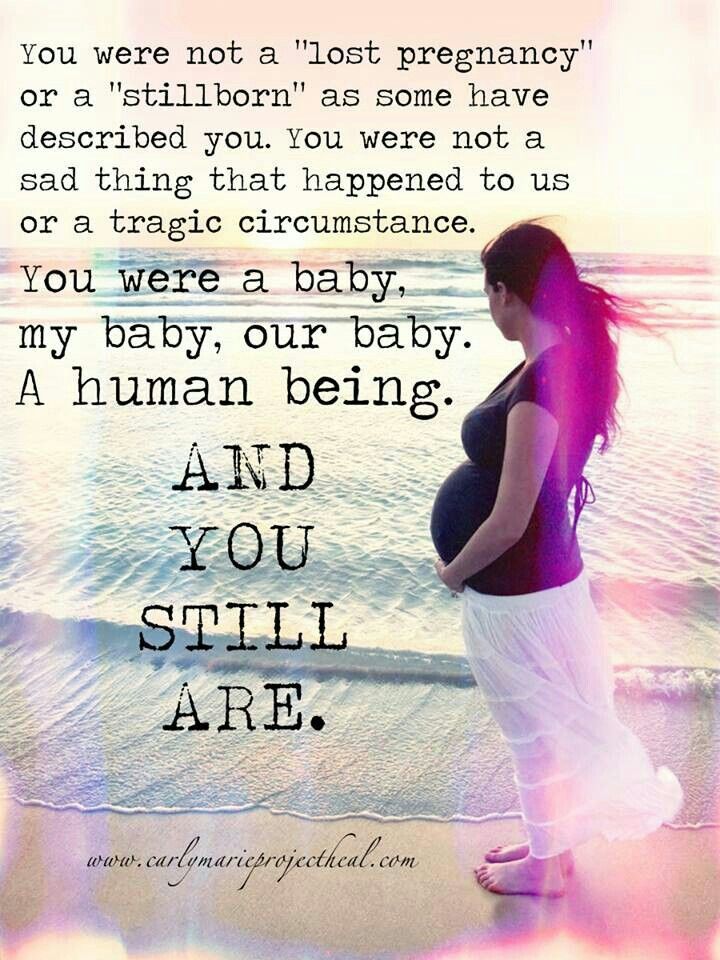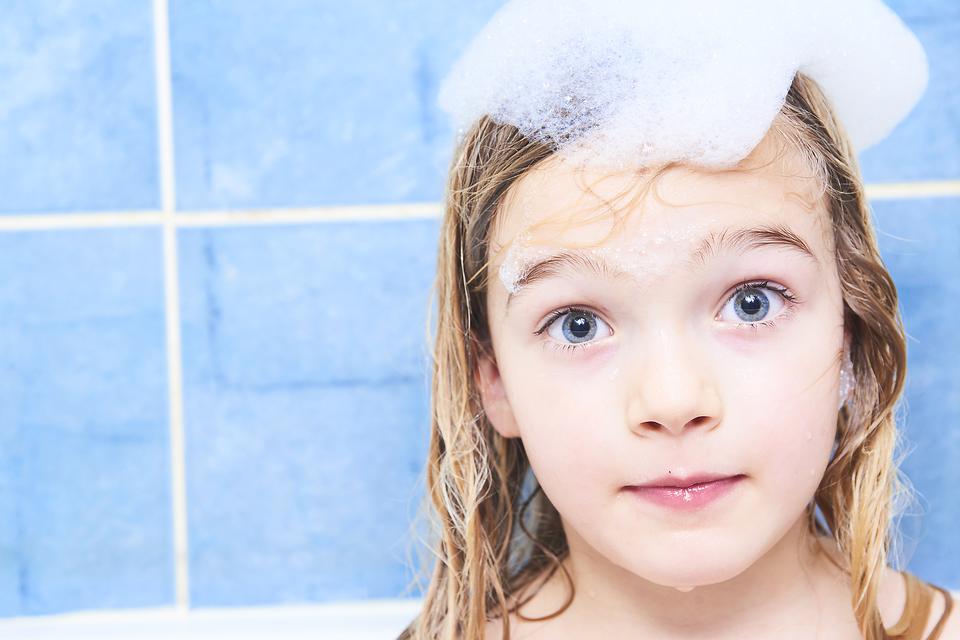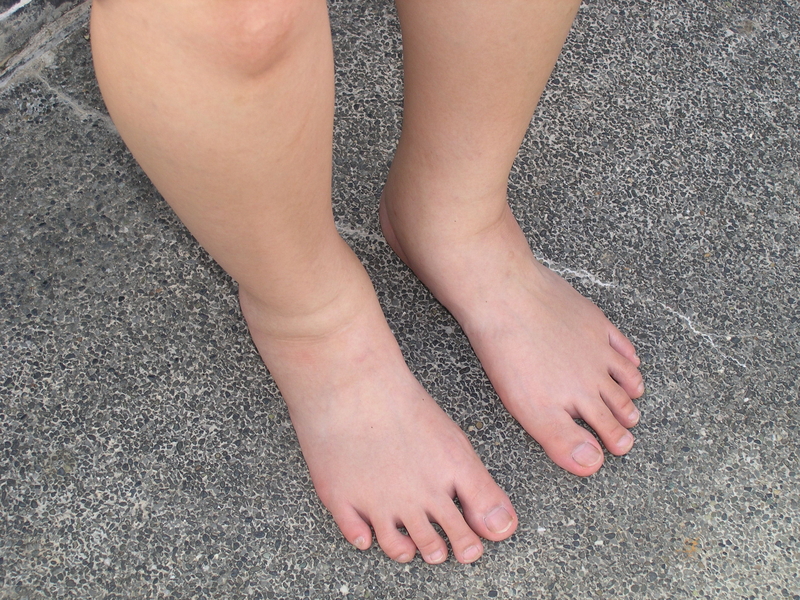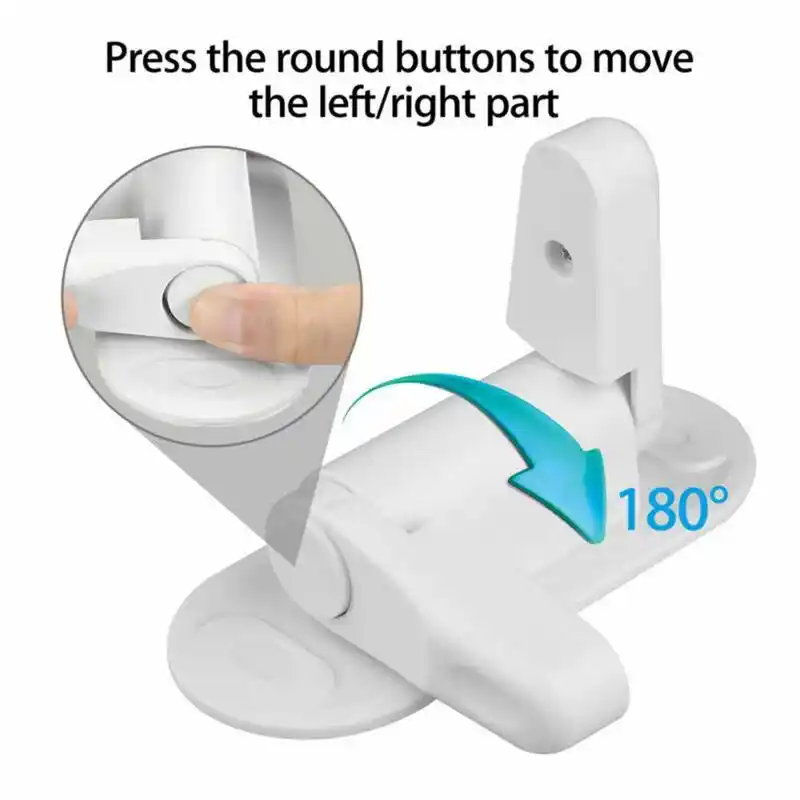Milestones for two month old baby
Your baby's developmental milestones at 2 months
Explainer
Everything you need to know about your growing 2-month-old.
UNICEF
Your 2-month-old is wide-eyed and curious, smiling at faces and engaging with everything around her/him. Babies at this age are social and love to interact. Here is how your little one will be growing, learning and changing during this sweet age.
| Social and emotional |
| Language and communication |
| Brain development |
| Movement and physical development |
| Food and nutrition |
| Things to look out for |
| Tips and resources |
| < Back to Parenting Milestones |
Social and emotional milestones at 2 months
Some of the ways you’ll see your little one learning to connect with the people around her at 2 months.
- Can self-soothe by sucking on her hand.
- Starting to smile at others.
- Attempting to look at her parents.
Tips for parents
- Engage in skin-to-skin contact. Your warmth will help soothe her.
- Hold your baby close to your face and make eye contact. This will help your little one learn your features.
Language and communication milestones at 2 months
How your baby is engaging and expressing his needs.
- Alerted by sounds and turns toward them.
- Making cooing noises.
Tips for parents
- Have “conversations” with your baby when he makes cooing noises by speaking back to him in a baby talk voice. This back and forth is important for helping him to develop language and communication skills.
Brain development milestones at 2 months
Your child’s brain is growing!
- Beginning to track people and objects with her eyes.
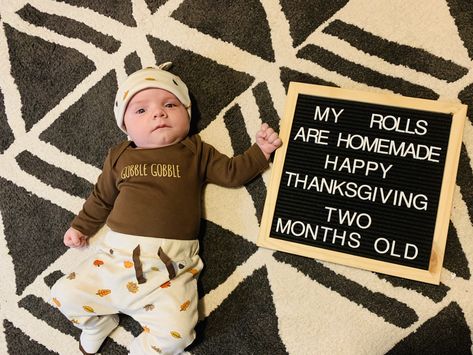
- Starting to get fussy if she’s feeling bored.
- Paying attention to the faces she sees.
Tips for parents
- Say the names of the objects or people your little one is showing interest in.
Movement and physical development milestones at 2 months
How he’ll move through his environment.
- Arm and leg motions will be smoother.
- Can push up while on his belly and hold his head up.
Tips for parents
- Participate in tummy-time with your little one by facing your baby and speaking with him while he is placed on his stomach in front of you.
- Encourage him to move his head, arms and legs by moving safe toys around him.
Food and nutrition milestones at 2 months
What mealtimes look like at 2 months.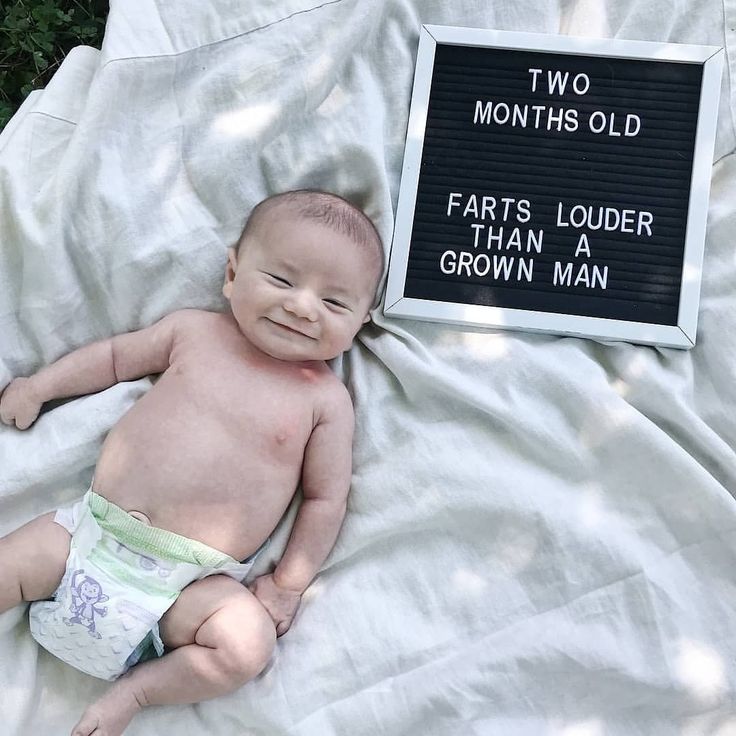
- All of the nutrition your baby needs can be found in breastmilk.
- She’ll easily suck and swallow during feeding.
- Her tongue will move back and forward to suck.
- She’ll latch onto her mother’s nipple or a bottle.
Tips for parents
- You should see signs of hunger about 8 to 12 times in 24 hours. Newborn babies need to eat a lot because they’re growing rapidly. They double their birth weight in the first six months of life, or before.
Things to look out for
While all babies develop differently, you should speak to your paediatrician if your 2-month-old:
- Can’t latch while nursing or bottle feeding.
- Loses a lot of breastmilk or formula out of the side of his mouth while feeding.
- Won’t smile at people.
- Doesn’t bring his hands to his mouth.
- Has no response to loud noises.
- Doesn’t track people and objects as they move.

- Is unable to hold his head up while on his tummy.
True or false?
Loading...
Explore age groups
2 Months | 4 Months | 6 Months | 9 Months | 1 Year | 18 Months | 2 Years
< Back to Parenting Milestones
Your baby's growth and development - 2 months old
beginning of content5-minute read
Listen
Your 2-month-old is growing fast and becoming more alert. They will be making more sounds and getting more skilled at moving their body. They will still be crying a lot - but you've probably already seen that magic first smile (usually at 6 weeks) which somehow makes all the hard work worthwhile.
Your 2-month-old
By 2 months, your baby will have put on a lot of weight and may be looking round and chubby. As their muscles develop, their arms and legs start to move more freely, stretching out to make them seem taller and leaner.
During their first 2 months, your baby is growing very quickly. They will keep growing at this rate, probably gaining about 900g and growing 2.5 cm to 3.8 cm every month.
Babies often have a growth spurt at about 6 weeks. This might make them more fussy because they want to eat more than usual. It might feel like you’re feeding all the time, especially at certain times of the day. You can sometimes tell your baby is hungry if they’re sticking their tongue out or sucking. If they doze off or turn their head away, they’re probably full.
At 6 to 8 weeks, your baby will have their scheduled vaccinations - 2 injections and the oral rotavirus vaccine.
Understanding baby growth charts
A growth chart helps you and your doctor keep track of how your baby is growing.
What can your baby do?
By 2 months your baby will have discovered their fingers and hands. They will hold their hands open and grab an object (although they don’t know how to let go yet!) They might also clasp both hands together.
2-month-old babies will start to learn how to coordinate their movements. Instead of the jerky arm and leg movements that made when they were born, they can move more smoothly and in more of a circular motion. They will kick both legs strongly and will be very wriggly. They may even roll over, so don’t ever leave them alone on a change table.
Their neck will be getting stronger all the time. During tummy time they might be lifting their head and moving it from side to side. Some babies can even lift their chest off the ground by now.
Some (though very few) babies can sleep through the night by the time they reach 2 months. But even if you’re not one of the lucky parents or carers, your baby will at least be sleeping for longer stretches at a time.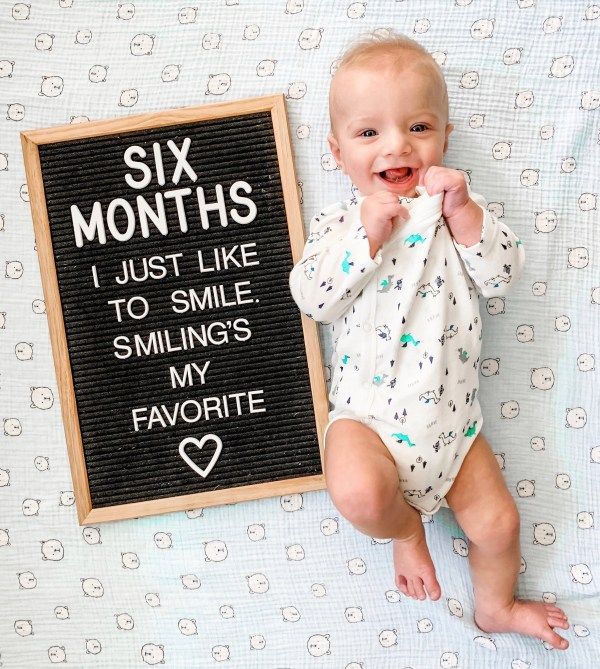 They’ll probably be having 2 to 4 long sleeps and will be more awake and alert during the day — although babies’ sleep patterns still vary widely at this age.
They’ll probably be having 2 to 4 long sleeps and will be more awake and alert during the day — although babies’ sleep patterns still vary widely at this age.
Your baby’s eyes, which may have been crossed when they were younger, move together most of the time now. They will clearly recognise you, will look at you when you talk to them, and can follow you with their eyes. They will love looking at your face and will be giving you some lovely smiles. They will like looking at objects with more complex patterns and colours.
They will also be making a lot more sounds and gurgling, including sounds like ‘a’ or ‘o’, and they will seem to listen to you and talk back to you.
How can I help my baby develop?
As your baby develops more of a rhythm, you’ll find they are awake more during the day. This gives you more time to interact with them and help them develop. Spend plenty of time reading to them, singing, and talking. That way they’ll get used to sounds and words and will start to develop language and communication skills.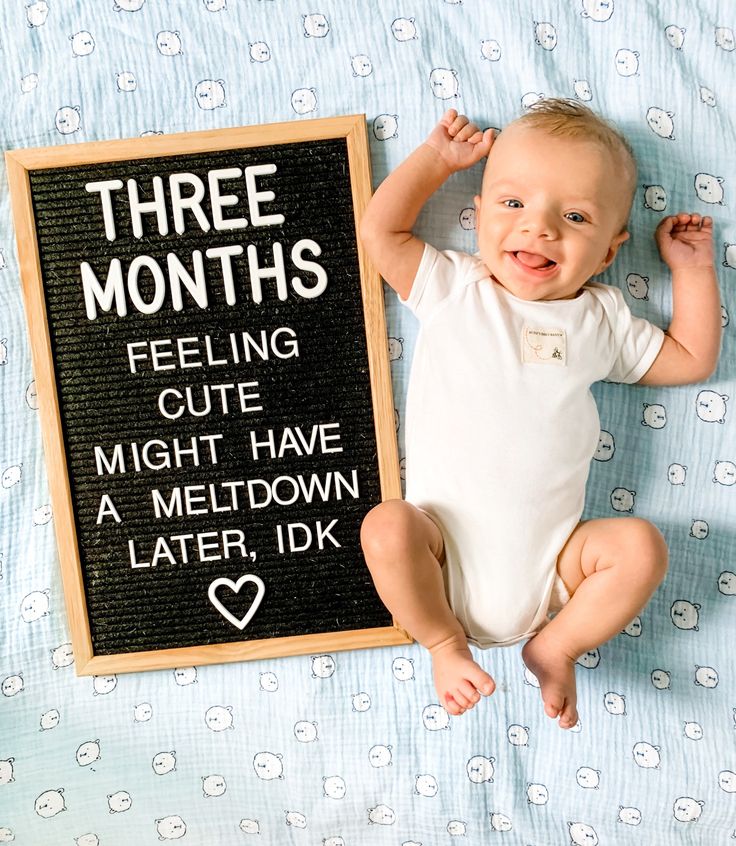
You can play with them by letting them look at and feel a variety of objects with different designs, colours, and shapes. Plastic toys and soft balls work well.
They will love looking at you, so make sure you smile at them a lot. It releases ‘feel-good’ chemicals in your baby’s body and helps them to feel safe and secure. You could also give your baby a massage to relax them. After a bath is a good time.
Continue with 1 to 5 minutes tummy time to strengthen their neck and upper body. It will help them develop the muscles they’ll need later to sit and crawl. But always put your baby to sleep on their back.
Development problem signs
Babies develop at a different rate. At 2 months, talk to your doctor or maternal child health nurse if:
- they aren’t smiling by 8 weeks
- they don’t calm down, even for a little while, when you pick them up to comfort them
- one side of their body seems to be stronger than the other
- they’re still holding their fingers in a tight fist
- sudden noises don’t startle them
- they aren’t feeding properly
- they’re floppy or stiff
Where can I go for help?
If you are worried or would like to discuss any issues with your baby’s development, speak to your doctor or child health nurse.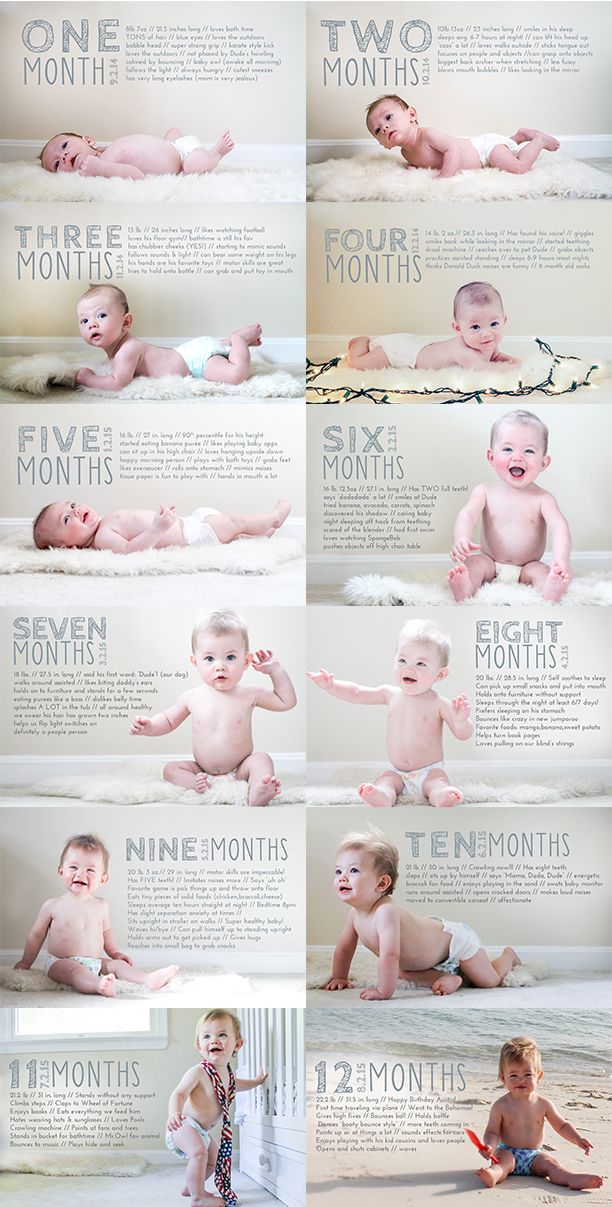
Speak to a maternal child health nurse
Call Pregnancy, Birth and Baby to speak to a maternal child health nurse on 1800 882 436 or video call. Available 7am to midnight (AET), 7 days a week.
Sources:
Raising Children Network (1-2 months: newborn development), Women's and Children's Health Network (Milestones: Children 0-4 years), Kids Health (Your baby’s health – 2 months), Australian Children's Education and Care Quality Authority (Developmental milestones and the Early Years Learning Framework and the National Quality Standards)Learn more here about the development and quality assurance of healthdirect content.
Last reviewed: October 2020
Back To Top
Related pages
- Bonding with your baby
- How your baby learns - birth to 3 years
- Your baby’s growth and development – first 12 months
- Understanding baby growth charts
This information is for your general information and use only and is not intended to be used as medical advice and should not be used to diagnose, treat, cure or prevent any medical condition, nor should it be used for therapeutic purposes.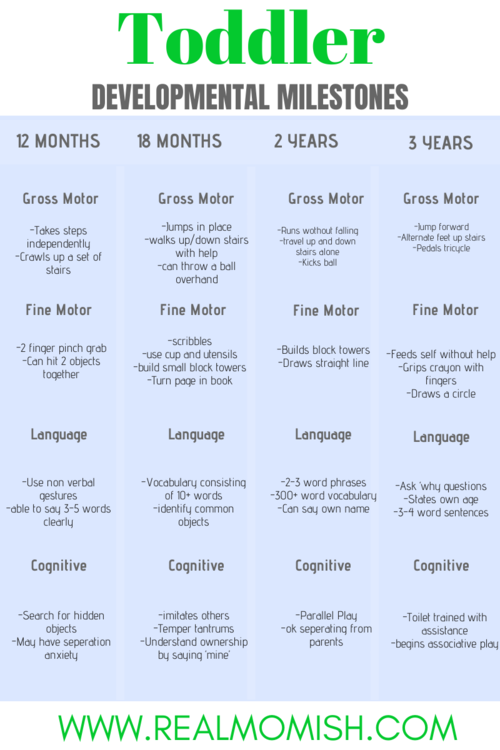
The information is not a substitute for independent professional advice and should not be used as an alternative to professional health care. If you have a particular medical problem, please consult a healthcare professional.
Except as permitted under the Copyright Act 1968, this publication or any part of it may not be reproduced, altered, adapted, stored and/or distributed in any form or by any means without the prior written permission of Healthdirect Australia.
Support this browser is being discontinued for Pregnancy, Birth and Baby
Support for this browser is being discontinued for this site
- Internet Explorer 11 and lower
We currently support Microsoft Edge, Chrome, Firefox and Safari. For more information, please visit the links below:
- Chrome by Google
- Firefox by Mozilla
- Microsoft Edge
- Safari by Apple
You are welcome to continue browsing this site with this browser.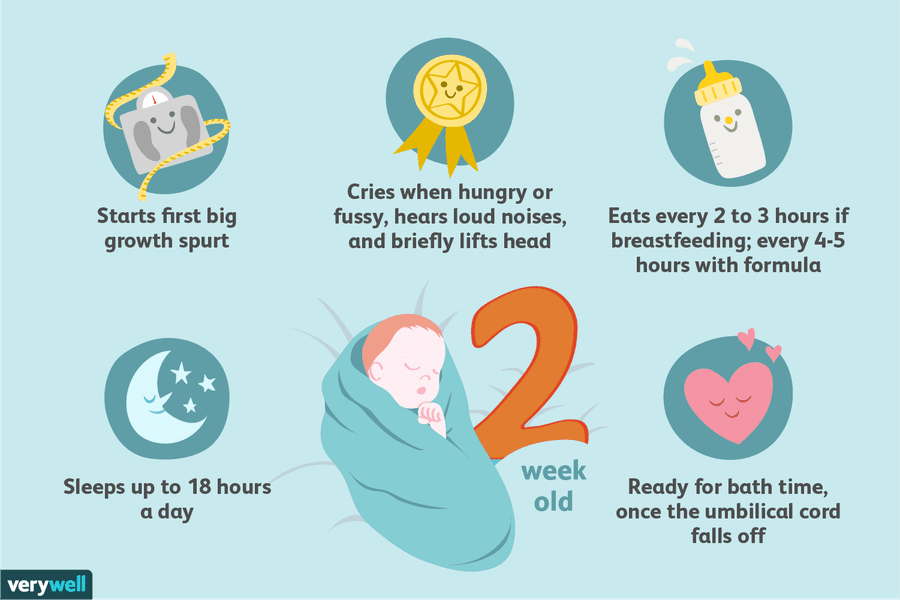 Some features, tools or interaction may not work correctly.
Some features, tools or interaction may not work correctly.
How to develop a child's speech. From birth to three years.
April 24
How to develop a child's speech. From birth to three years.
Many parents believe that before their child utters the first words (and this usually happens at the age of about a year), it is useless to talk to him, because he, they say, still does not understand anything and still cannot learn anything. Nevertheless, “obscure sounds” are already the formation of speech, and it begins long before the first words appear. And already at this, the very first stage, the main function of speech is clearly visible - communication.
Teaching a child to speak consists mainly of how you speak to the child and how you explain to him with the help of words various actions and manifestations. The child gets acquainted with the things that you name him. And if you want to develop his speech, then you and your environment must verbalize, i.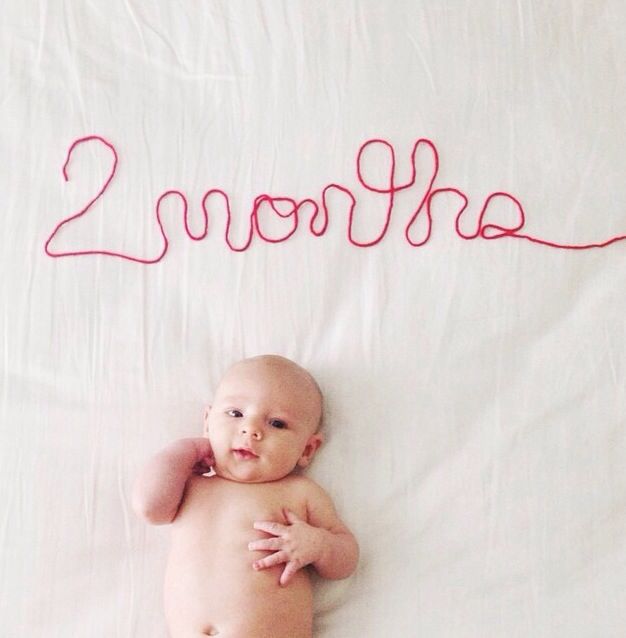 e. to translate into words, to explain in words the various actions that he performs.
e. to translate into words, to explain in words the various actions that he performs.
0 to 1 month
Hearing and vision of newborns work from the first days of life. If you drop something with a crash, the child will wrinkle and cry. Offer the baby interesting objects to look at, and by about the tenth day of life, he will follow the moving toy with his eyes. Above the crib, strengthen something that sounds, if the baby accidentally touches the toy with a pen, the sound will attract his attention. Leave the child's hands free, because for development it is very important to study your hands, to watch how they move.
Remember that a child receives all knowledge about the world around him by observing and communicating with you. Do not leave him alone for a long time and do not be a silent mother. Be sure to hug your baby, stroke the back, tummy, arms, legs, let him feel your love.
1 to 2 months
Try to communicate with your baby as much as possible.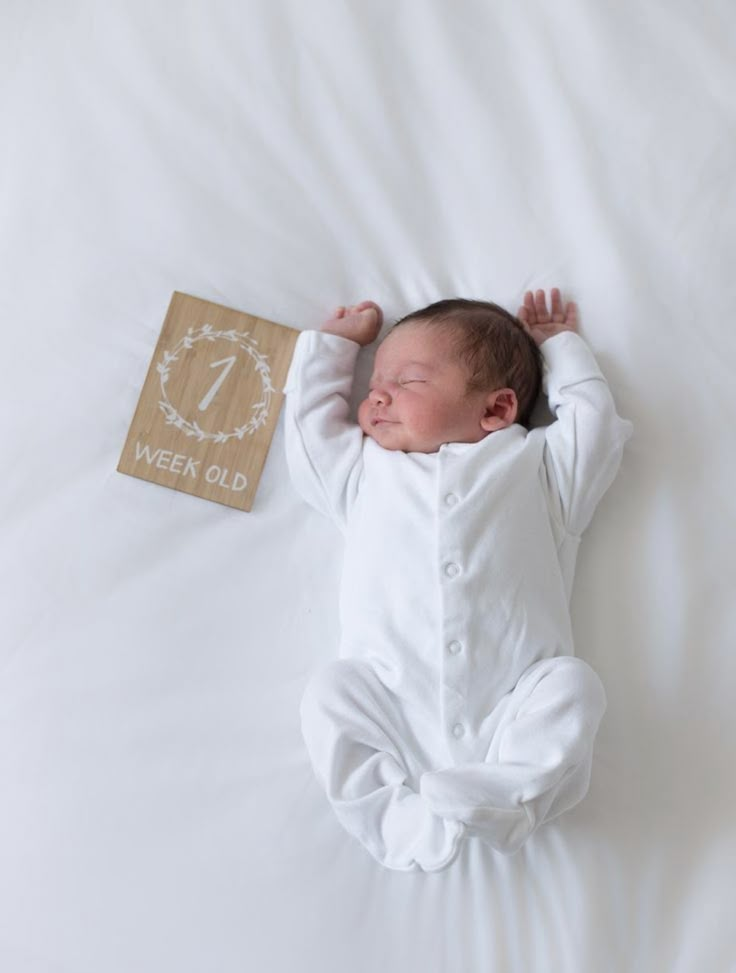 Speak affectionately, calmly, smile and try to interest the child in your speech. For him at this age, not so much words are important as intonation, facial expressions and gestures. Your baby will quickly figure out that you can get attention by shouting. And you, having determined by crying what is bothering the child, say what you are doing: “You are hungry, now we will eat”, “You are wet, now we will change your diaper”, etc.
Speak affectionately, calmly, smile and try to interest the child in your speech. For him at this age, not so much words are important as intonation, facial expressions and gestures. Your baby will quickly figure out that you can get attention by shouting. And you, having determined by crying what is bothering the child, say what you are doing: “You are hungry, now we will eat”, “You are wet, now we will change your diaper”, etc.
2 to 3 months
Now the toys that have fallen into the field of view of the child, he examines carefully. Try to catch what the child's eyes fell on and name this object to him. Give your baby as many opportunities as possible to hear your speech and try to repeat it. Coo, talk, repeat the sounds uttered by the little man, and be sure to smile at the same time. When you hear the child hoot, answer him, let him know that you hear, understand that you like the sounds the child makes. Take a rattle and rattle it, move it so that the child can see it. He will follow her with his eyes, and when you put her in his hands, he will grab her tightly and try to shake her.
He will follow her with his eyes, and when you put her in his hands, he will grab her tightly and try to shake her.
3 to 4 months
Now the baby is looking at you completely meaningfully (up to three to four months, the vision of newborns is considered underdeveloped). You smile at him, and he smiles back at you, he even already knows how to laugh loudly and cheerfully. When you put the baby on his tummy, he holds his head well and for a long time, which means that the view also increases. Lay out various objects in front of him, giving him the opportunity to carefully examine them, and do not forget to explain everything to the child. Name and pronounce everything that the child does and everything that you do. At this age, the baby becomes very active, rolls over on his own, carefully looks at moving toys and is well guided by the voice. When talking with him, move away and bring your face closer, deviate to the side, move away so that he does not see you, but only hears you.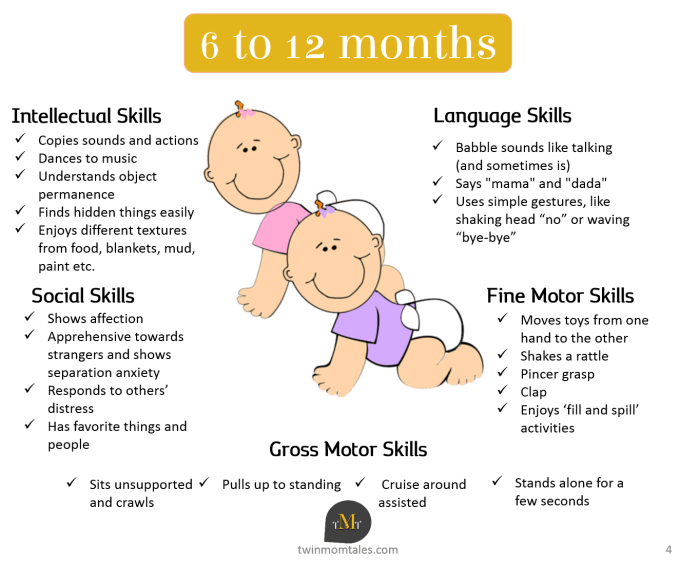
When playing with your child, use no more than two toys at a time. First of all, let the baby see the toy, move it around him, touch the baby with it, hide it, let the child try to find it by sound. You can hang toys above the crib that are easy to grab, they should be bright, simple and safe.
At three months it's time to start playing the "horned goat":
There is a horned goat,
For the little guys,
I gore, I gore, I gore.
The child will laugh merrily at the approach of a formidable two-fingered horned goat.
4 to 5 months
At four months, the child begins to walk. When you hear a hum, be sure to answer it.
Now it's time for some simple language exercises. Sitting in front of the baby, stick out your tongue, puff out your cheeks, lick your lips and sing different sounds, let him imitate you. When the child squeezes the toy in his fist, try to pretend to take it away, saying: "That's how tight you hold the toy, well done! Now give it to me," etc.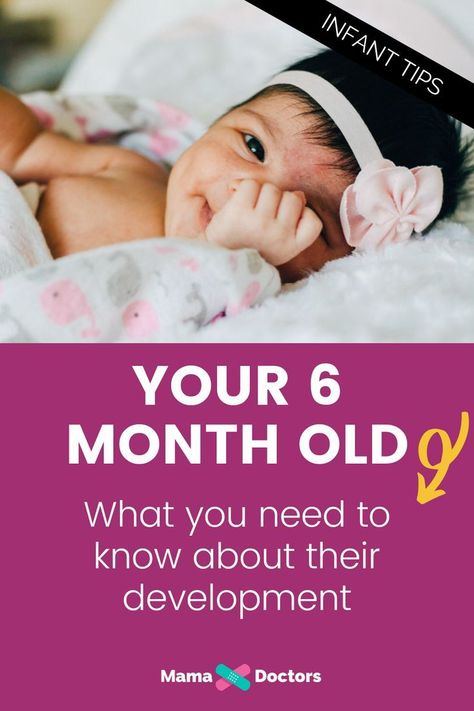
Place toys where the child can reach them. At first, you can help him by slightly moving the toy, while encouraging the baby to reach for it himself. In the future, try to get the child to get an interesting object on his own. Your baby will try to put everything in his mouth, do not interfere with this, because this is an important stage in the study of objects. Just make sure that there are no small parts that can be swallowed and that all items are clean.
Talk to your baby more and more often, saying everything you and your baby do. At the same time, try to diversify the intonation with which you speak.
5 to 6 months
Now your baby can listen to melodious music with pleasure. Let the music be heard now closer, then farther, sounds now to the right, then to the left. A five-month-old baby is very interested in musical toys. He carefully feels them, shakes them and examines them with interest, bringing them to his face. Offer him sounding toys of varying degrees of volume. Imperceptibly move away the toy that interests the baby, stimulating the child to crawl after it.
Imperceptibly move away the toy that interests the baby, stimulating the child to crawl after it.
Do not forget to discuss with the baby everything that is happening around. The child does not yet understand the words, but the tone in which they are pronounced catches excellently. Therefore, talk to him affectionately and calmly, smile at him more often.
Also now is the time to start playing hide and seek. You cover your face with your palms and ask the child: “Where am I?”, And opening your face with the words “Ku-ku” (or “Here I am!”), While smiling broadly. You can diversify the game by hiding behind different pieces of furniture, and appearing from there, saying "And here I am."
6 to 7 months
At six months, the child begins to repeat individual syllables, having heard this, repeat after him and finish the word, for example, "ma-ma, ba-ba." Talk more with the baby, let him imitate you as much as possible, listen to your speech. It is imitation that develops the mobility of the lips and tongue, and the child develops the skill to respond to your words.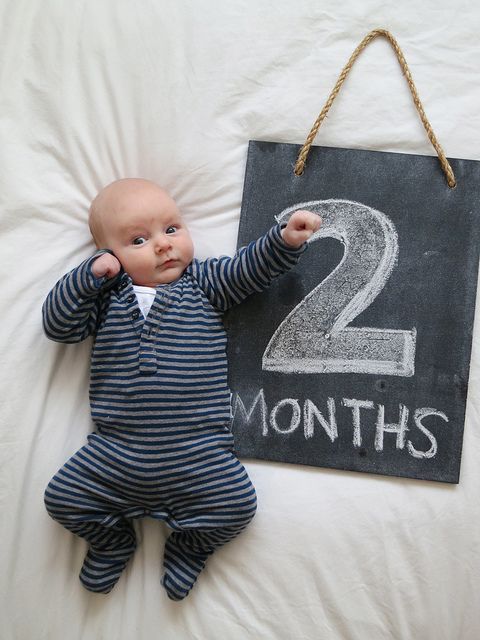
A six-month-old child already plays well with toys, and when a toy falls, he begins to look for it, to reach for it. Help the baby while saying: "Where is our dog? The dog has fallen, now we will pick it up. Here is the dog, take the dog." Now the child is attracted to toys where something changes, moves or is taken out.
Leave the baby alone for a while, let him try to occupy himself. This will teach him to focus and begin to teach him to be independent.
7 to 8 months
Your child has become more active, he no longer drops toys, but tries to throw them. Why swing a rattle, it is better to knock it with all your might on something. Try to speak slowly with the child, use one-two-syllable words, because the baby can already repeat some of them. Showing the child a toy, call it: "Where is our dog? Here is the dog. How does the dog bark? Av-av" Then put the toy aside and ask him where the dog is, he will turn his head in the direction where you put the toy.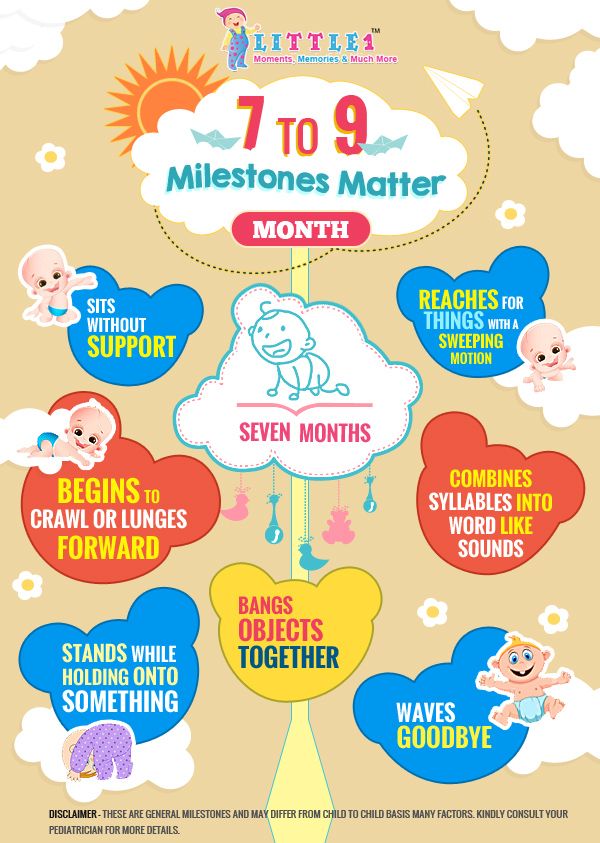 Voice for him various animals, both toy and real.
Voice for him various animals, both toy and real.
Give the child lids from pots, empty boxes, jars, show him the sounds that occur when they are tapped against each other. Just do not forget about the safety of the baby, do not give him breakable objects and those that can be swallowed.
At this age, you can try to play patty.
8 to 9 months
If you ask your eight-month-old baby to sit, stand, give a pen, he will do it all with pleasure. Therefore, ask him to repeat after you a variety of movements. Continue to play the hidden toy, cover the toy rabbit with a diaper and ask where it is. The baby will immediately tear off the diaper from the toy, and you will definitely praise him for it.
Now you will need a soft toy, such as a dog. Considering a toy with your child, say: "This is a dog. Here are the ears of the dog. Where are the ears of the dog? But the eyes. Where are the eyes of the dog?" Then you can show how the dog walks, barks, growls, eats.
For the development of breathing, use turntables, pipes, pieces of paper that need to be blown away.
Name even objects well-known to the baby, explain them in different situations, this will help him remember and use these words faster and easier.
9 to 10 months
A nine-month-old baby can already be offered to put nesting dolls into each other, string the rings of a small pyramid. Try to ask him "Give me a cube" - and he will give it to you. "Drop it!" - tell him, and he will throw the dice.
Constantly talk to the baby, explain everything to him, but do not overload with complex information. When talking with your child, encourage him to repeat different sounds, syllables, words. When playing with a doll, we show her eyes with a finger and call them, then our own, then the eyes of a child. Next, we continue to look for the eyes of a bear, cat, grandmother, dad. Thus, we study all parts of the face. Place a mirror in front of the baby, let him examine himself, touch his nose, eyes and ears, looking at himself in the mirror.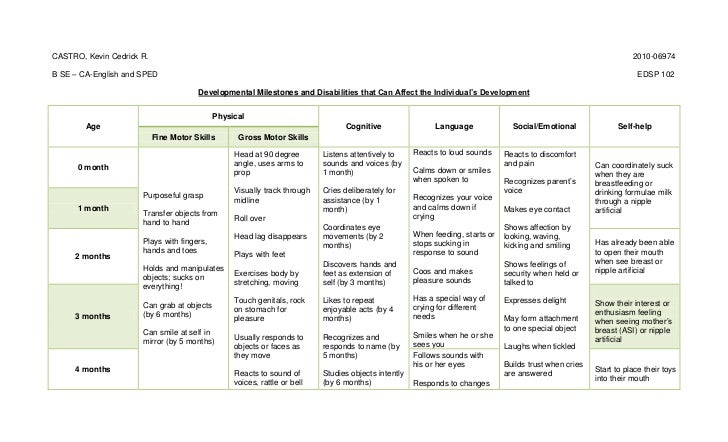 Be sure to explain everything to the child: "And who is this in our mirror? And this is Sasha. Here are Sasha's eyes, but Sasha's ears," etc.
Be sure to explain everything to the child: "And who is this in our mirror? And this is Sasha. Here are Sasha's eyes, but Sasha's ears," etc.
You can try to paint with finger paints, maybe your fidget will like it.
10 to 11 months
The baby can begin to pronounce words at this age. Don't worry if this doesn't happen, because all babies are different and your baby can say his first word at 11 or 12 months. This is also normal. Your child already understands a lot and it's time to introduce the word "not", but only in relation to what is really NOT.
Now your baby willingly comes into contact with you. He pretends to be hiding, playing peek-a-boo, pretending to be afraid of the "horned goat". He knows how to open boxes, roll cars, collects a small pyramid. You still label your actions and your child's actions with words. It is necessary that the baby gradually learns: each item is somehow called. Try the same game, you scatter several different toys, and offer your child to collect them in a box.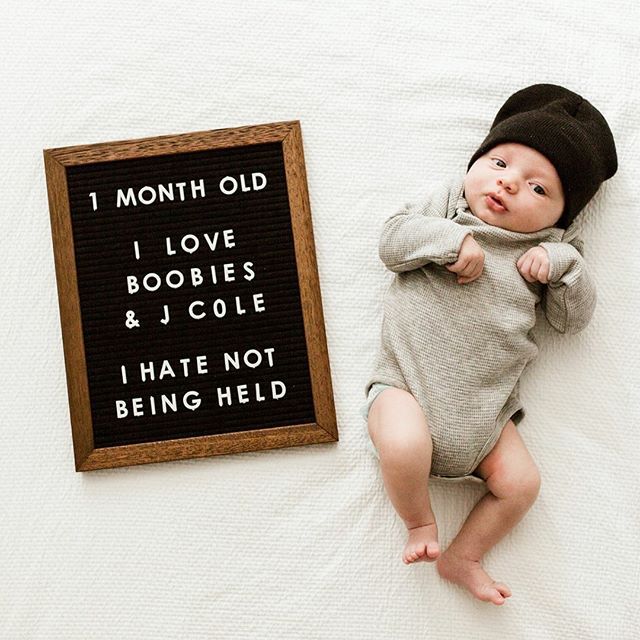
It's time to start playing White Sided Magpie and other finger games - it develops fine motor skills very well and stimulates the development of speech. :
White-sided magpie,
Cooked porridge,
She fed the kids.
Gave it to,
Gave it to,
Gave it to,
Gave it to,
But she didn't give it!
He didn't saw wood,
Didn't carry water,
Didn't cook porridge.
When reciting a rhyme, we bend in turn all the fingers of the baby, starting with the little finger, except for the big one.
The time has come for drawing with pencils. Give your child a pencil, a sheet of paper, and let them draw scribbles for their own pleasure. Instead of pencils, wax crayons can be used.
11 to 12 months
Your baby continues to get acquainted with the outside world. All adults in the house should use every opportunity to talk with the baby, to teach him something.
Play "magic bag" with your child.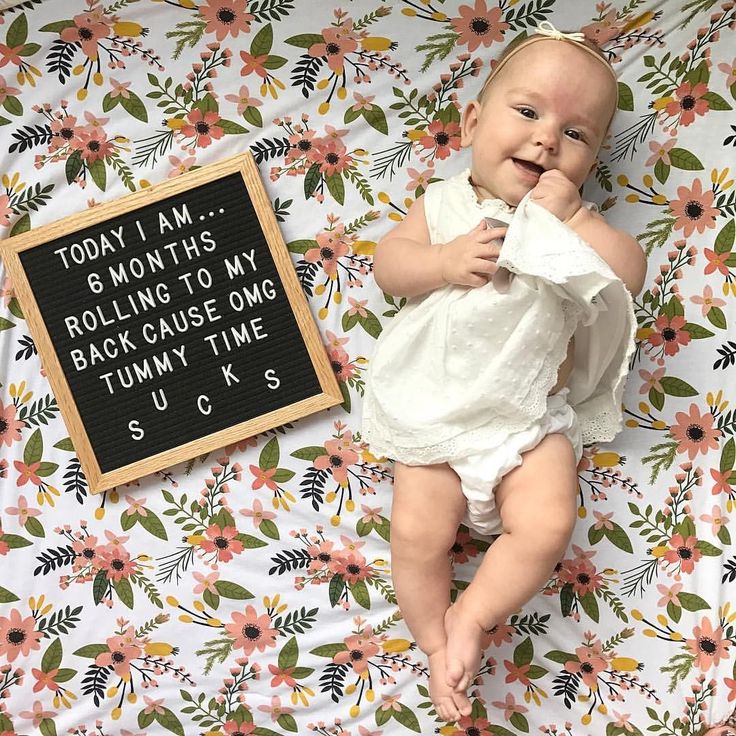 To do this, collect a few animal toys in a small bag (you can use a small pillowcase). Show the dog's head from the bag and ask the child who it is. After hearing the answer, ask how the dog barks, what he eats, where he lives, how he walks, etc. If the child does not know this, then answer yourself, and let him listen.
To do this, collect a few animal toys in a small bag (you can use a small pillowcase). Show the dog's head from the bag and ask the child who it is. After hearing the answer, ask how the dog barks, what he eats, where he lives, how he walks, etc. If the child does not know this, then answer yourself, and let him listen.
Start playing story games: we put the doll in a crib, we drive the car into the garage, we feed the bear with porridge. Constantly show and explain to the child your actions, but do it not in a strict tone, but very kindly. Sit on the sofa with the baby, take a book and look at the pictures together, naming them, while letting him turn the pages himself.
Do not forget about music, right now its perception is laid. Quiet, melodic music is useful for a child's nervous system, but always be guided by the preferences of your baby.
Communicate more with your child, name everything you see around you, the actions of people and actions with objects during a walk.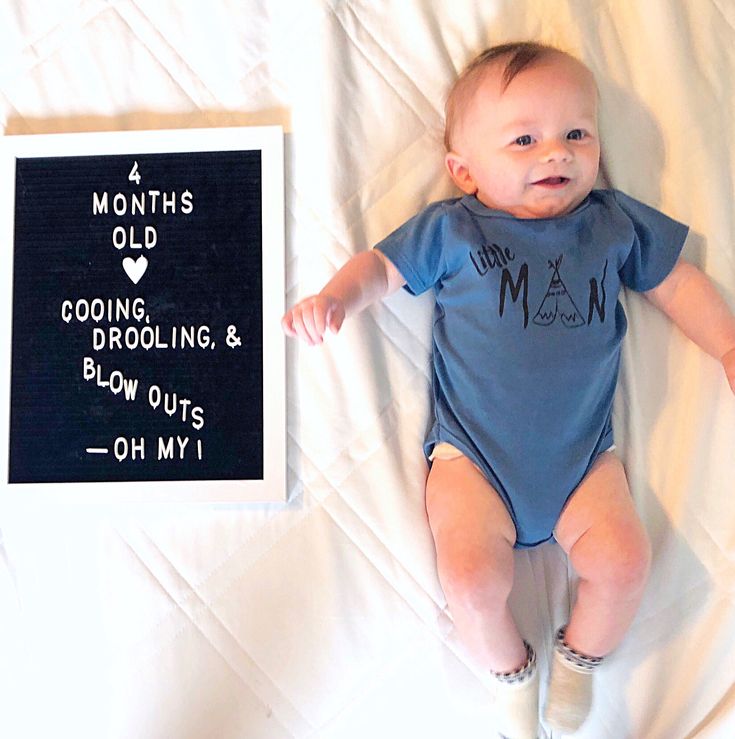 If the baby goes to kindergarten or spends the weekend away from home, discuss how his day went, your day, what plans you have for tomorrow. In addition, you can use special exercises and games.
If the baby goes to kindergarten or spends the weekend away from home, discuss how his day went, your day, what plans you have for tomorrow. In addition, you can use special exercises and games.
For children under 2 years:
• "Repeat after me". Start doing actions with some toy, for example, with a bear. Say actions: “Look, I feed the bear. Like this. Now you feed the bear… What are you doing?” - “I feed the bear”, etc.
• "Play the pipe." Buy a pipe (or whistle) for your baby, let him learn how to blow into it, this will help develop exhalation strength. Soap bubbles can be used to form a long exhalation.
For children under 3 years:
• "Choose from two". Pick up pictures depicting objects whose names differed in one sound, for example, “mouse-bear”, “house-smoke”, “nose-knife”, ask the child to show where one object is and where the other is.
• Joint retelling of familiar fairy tales with a repetitive plot: "Turnip", "Teremok", "Zayushkina's hut", etc.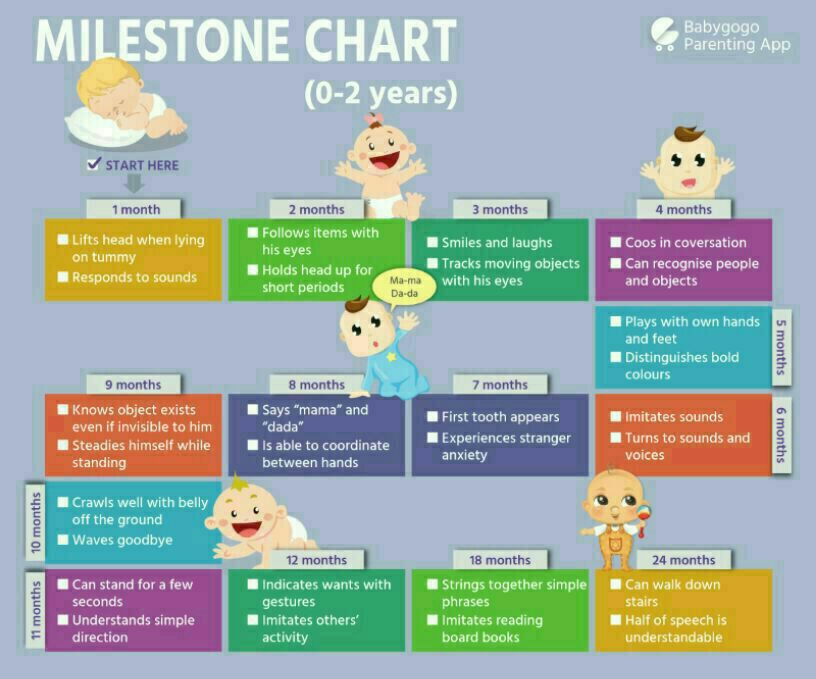
lower jaw.
The main stages in the development of a child's speech.
First stage - cry
After birth, the baby sometimes feels some kind of discomfort - and screams (still at the level of an unconditioned reflex). When the needs of the baby are satisfied, a certain stereotype of behavior is formed in the child, and the cry becomes a signal of discomfort (wet, hungry or sleepy, sad, lonely). Gradually, with the help of a cry, the baby learns not only to attract attention to himself, but also to communicate. Remember, when your baby calls you, he first screams, and then waits for an answer: will mom come or won't she? Then he screams louder and waits again. Thus, the child gives his "interlocutor" the opportunity to join in his first dialogue. By about the third month, the intonation of cries also changes. An attentive mother can distinguish a lot of different cries of her child - it can be grumbling, whining, discontent, a sharp screech of pain, angry "exclamations".
Second stage - cooing
Usually these are various variations of sounds: a-a-gu, gee-s, ge-e, a-gee, etc. It is curious that babies of different nations walk the same way. In cooing, as in screaming, the moment of interaction is also important. The kid can walk and be left alone in the room, but with your appearance, the walk becomes more active. If you look closely at the child, you will see that he does not just make sounds. The kid at this time looks into your eyes, waits for your answer, he is already trying to build a full-fledged speech dialogue. And this dialogue must be supported! After all, while cooing, a child learns to coordinate both voice and gaze, which will later become the basis of any social contact. Answer the baby in his language, support and encourage his first "performances" in every possible way. Gradually, the child begins to pronounce long chains of sounds, as if imitating himself. And he will try to imitate you too. A baby at this age is trying to feel sounds and words for the first time.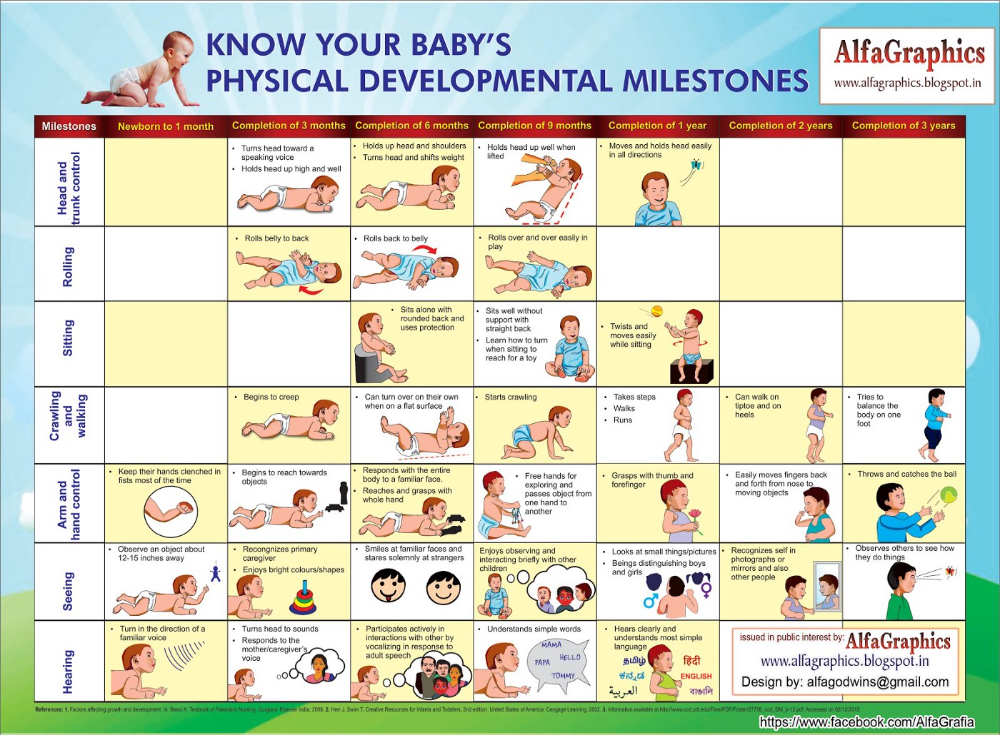 So far, it is not so much the meaning of words that is important for him, but different intonations, the rhythm of speech, the articulation of various sounds.
So far, it is not so much the meaning of words that is important for him, but different intonations, the rhythm of speech, the articulation of various sounds.
Third stage - babbling
As the child develops, the cooing subsides, and babble comes to replace it. This usually happens at the age of 6-7 months. Your baby begins to pronounce the individual syllables "ba", "ma", "ta", etc. - at first once, very rarely and as if by accident. Gradually, syllables are heard more and more often in his speech, they are repeated in the form of chains: ba-ba-ba-ba, ma-ma-ma-ma.
Cooing and babbling are very important for the further development of speech. If your baby does not have them, try to activate them.
Holding the child in your arms so that he can clearly see the movement of your lips, repeat various syllables, sing rhythmic songs, read simple rhymes, and most importantly, talk to the baby as much as possible. He needs to hear adult speech.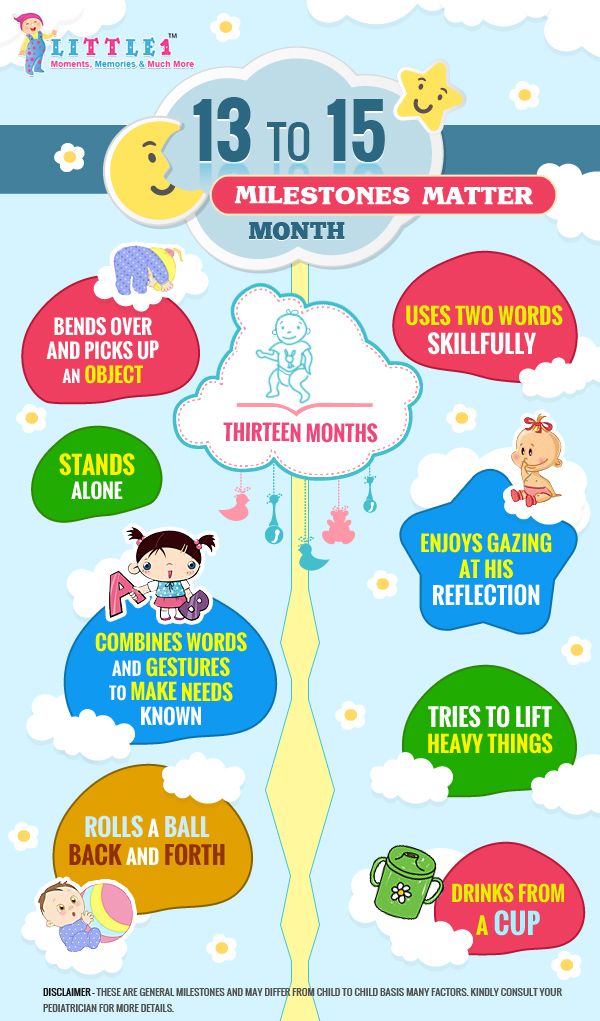 However, these should not be just conversations that adults have with each other, but a speech addressed specifically to him, to the child.
However, these should not be just conversations that adults have with each other, but a speech addressed specifically to him, to the child.
Stage four - first words
At this stage (usually it starts at 11-12 months) it is very important to help the child in his word creation. Right now, the baby begins to associate words with environmental objects, words are filled with meaning for him. Now you can expand your repertoire of reading aloud. Try to call things by their proper names (not "Let's put this thing over there", but "Let's put the doll in the crib"). Do not forget to comment on your actions when you are with your baby.
Speech therapists advise to train the muscles of the lips and cheeks. To do this, stock up on various whistles, harmonicas, a toy flute and teach your baby to blow into these instruments. It is also useful to blow soap bubbles (however, you will have to constantly monitor so that the child does not drink the soapy solution).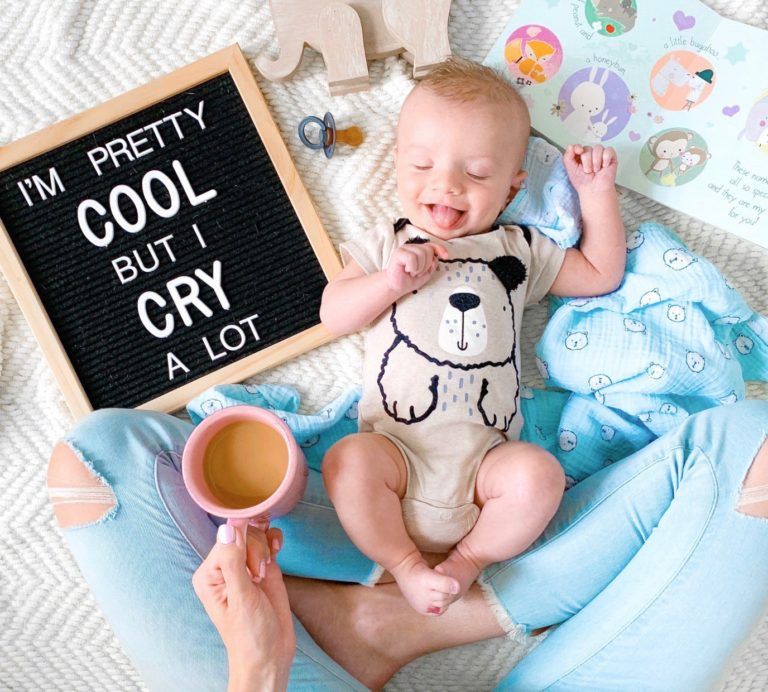 Another fun way to exercise your lip and cheek muscles is to make faces with your baby. Do not hesitate to make funny faces, expressively portray a variety of emotions (surprise, fear, joy), stick out your tongue, lick your lips.
Another fun way to exercise your lip and cheek muscles is to make faces with your baby. Do not hesitate to make funny faces, expressively portray a variety of emotions (surprise, fear, joy), stick out your tongue, lick your lips.
The first words will be onomatopoeic: bang, boom, woof-woof, beebika. Do not be afraid of these infantile, "lyal" (as my eldest daughter says) words. This is a very important moment in the development of speech. It is still difficult for a child to associate an abstract word (for example, dog, car, fell) with a specific object or action. If the word is at least somewhat similar to an object or action, such a connection is much easier to establish (for example, a dog says “av-av”, a car says “beep”, and a falling object makes “boom”).
When your baby tries to repeat some words after you, you can read poems “by roles” . For example, the famous poem about geese:
Adult: Geese, geese!
Child: Ha-ha-ha!
Adult: Do you want to eat?
Child: Yes, yes, yes!
Adult: Bread and butter?
Child: No, no, no.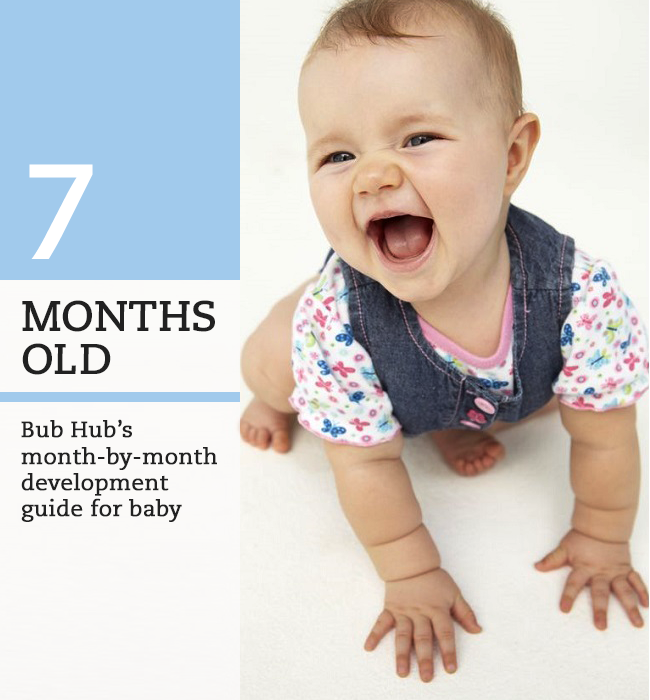
Adult: What about you?
Child: Candy!
Adult: Well, fly as you like, just take care of your wings. They flew and flew (the child waves his arms), sat on his head.
When you read familiar poems or sing songs to your child, pause at the end of the line so that the child can complete the line.
Words and gestures
For young children, non-verbal communication is even more important because at some stage it is the only way for them to "talk" to you. It is very useful to reinforce words with certain gestures. First, the baby learns to reproduce the gesture, and then he repeats the word. At the same time, try to use the words “give”, “bring”, “take” more often, ask the child to fulfill simple requests.
Don't be shy about childish gestures, such as pointing fingers, but on the contrary, help your child learn them. Gestures can also carry emotional overtones. With gestures, the child can accompany your reading of poetry or singing.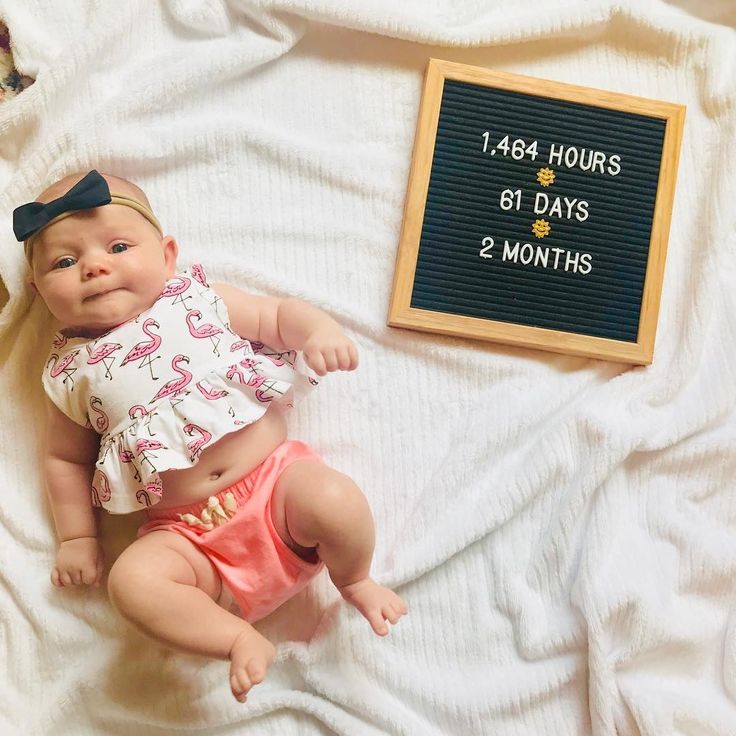 For example, like this:
For example, like this:
I play the violin - tili-li, tili-li, (the kid holds an imaginary violin in his hands and “plays” on it),
Bunnies are dancing on the lawn - tili-li yes tili-li (“dancing”, twirling with raised arms).
And then on the drum - bam-bam-bam, bam-bam-bam (the child taps his palms on some surface),
In fear, the bunnies ran into the bushes! (hides face in hands).
Or like this:
A clumsy bear walks through the forest (the child sways with his legs wide apart),
He collects cones, sings songs (bends over an imaginary cone).
Suddenly a bump fell right on the bear's forehead (slaps his forehead).
The bear got angry, and with his foot - the top (the baby stamps his foot).
Or like this:
Zainka, dance, gray, dance. Dance like this, dance like this, dance like this (the child “dances”).
Zainka, stomp your foot, gray, stomp your foot, stomp your foot like this, stomp your foot like this, stomp your foot like this (stomps one or the other foot).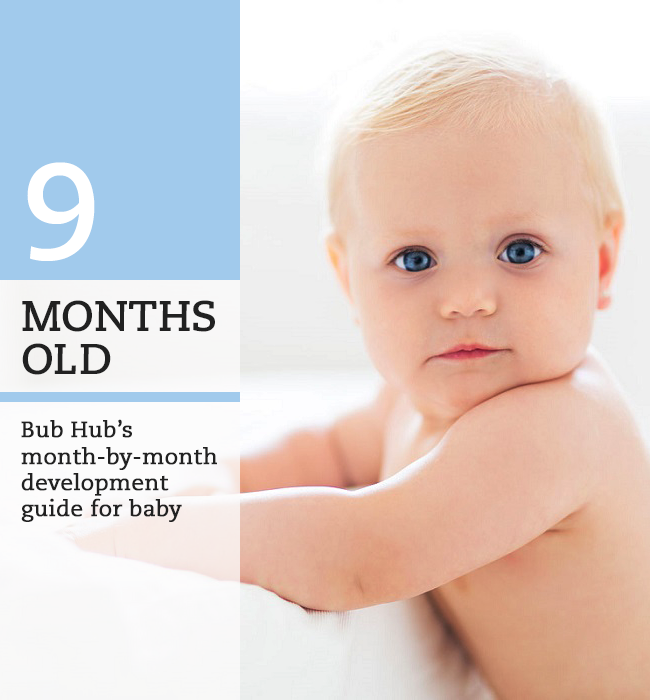
Zainka, clap your hands, little gray one, clap your hands, clap your hands like this, clap your hands like this, clap your hands like this (the baby claps his hands).
Hare, bow, gray, bow, bow like this, bow like that, bow like that (bows).
You can also beat "Toys" by Agnia Barto. The kid shows how the bull sways on a shaky board, how the girl Tanya cries bitterly, pities and strokes the poor bear with its paw torn off.
Needless to say once again that the famous finger games simultaneously train the child's "talking gestures" and fine motor skills, which are also very useful for the development of speech. These games will help your toddler build vocabulary and match words to very specific actions or objects.
It is important to note that when parents understand the child too well without words, there is simply no need for him to convey any message to them. Perhaps here sometimes you have to be a little tricky, pretending that you do not understand what the child wants from you until he tries to tell you about it.
If a child communicates with you using babbling, gestures, his first words are about to appear. Don't worry if it happens a little later than you think it should. Do not compare your baby with the girl next door, the son of a friend and the niece of your colleague! The development of each individual child may have its own individual characteristics. However, there are some important milestones in your baby's speech development that you should pay special attention to:
Cry , which is initially a reaction to discomfort (hunger). Too quiet and maximally comfortable child is not so good as it seems.
Revitalization complex (smile, animation) when an adult appears (appears at 1-3 months).
Cooing. How and when does your baby walk? Does he look into your eyes at the same time, does he “sing” his baby songs while in your arms, do you feel his need for communication?
Babble (appears at 6-10 months), the child clearly attracts attention with the help of some sounds.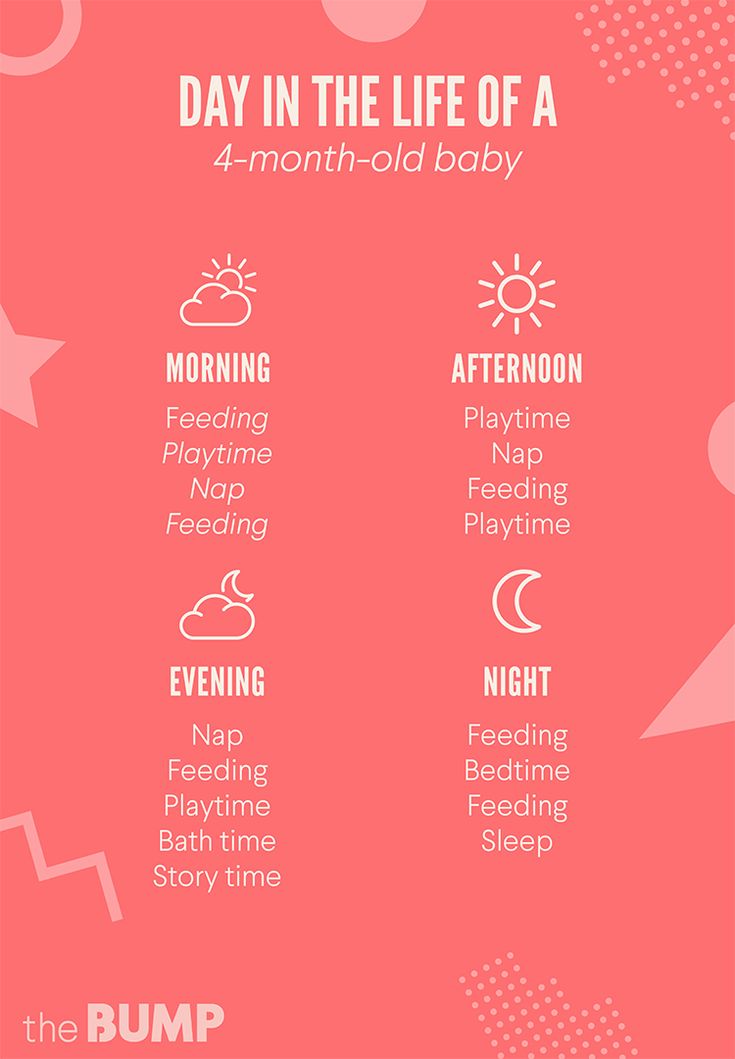
Pointing gesture (appears at 8-13 months). This is a very important moment in the development of the child, preceding the appearance of the first words, because before naming an object, the baby needs to learn how to show it.
Emergence of basic social gestures eg goodbye (9-12 months).
Understanding and fulfilling simple requests , the appearance of elementary story games (feed the doll). The child usually passes this stage at the age of about one year.
Special techniques for developing speech and stimulating speech activity.
Talking to yourself.
When the baby is close to you, start talking out loud about what you see, hear, think, feel. You need to speak slowly (but without stretching the words) and clearly, in short, simple sentences - accessible to the perception of the baby. For example: “Where is the cup?”, “I see a cup”, “The cup is on the table”, “There is milk in the cup”, “Tanya drinks milk”, etc.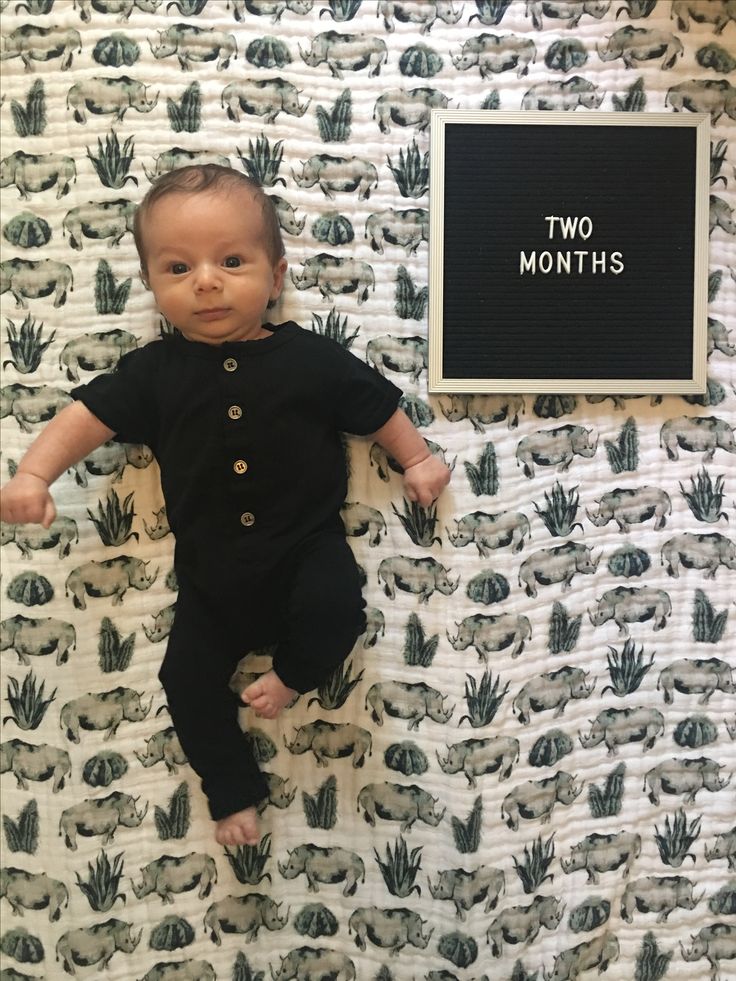
Parallel conversation.
This technique differs from the previous one in that you describe all the actions of the child: what he sees, hears, feels, touches. By using Parallel Talk, you are prompting your child for words that express his experience, words that he will later begin to use on his own.
Provocation or artificial misunderstanding of the child.
This technique helps the child to master situational speech and consists in the fact that the adult is in no hurry to show his understanding and temporarily becomes "deaf", "stupid". For example, if the baby points to a shelf with toys, looks at you pleadingly and you understand well what he needs at the moment, try giving him the wrong toy. Of course, the first reaction of the child will be indignation at your dullness, but this will also be the first motive that stimulates the baby to name the object he needs. If there is a difficulty, tell the baby: “I don’t understand what you want: a pussy, a car doll?” In such situations, the child willingly activates his speech capabilities, feeling much smarter than an adult.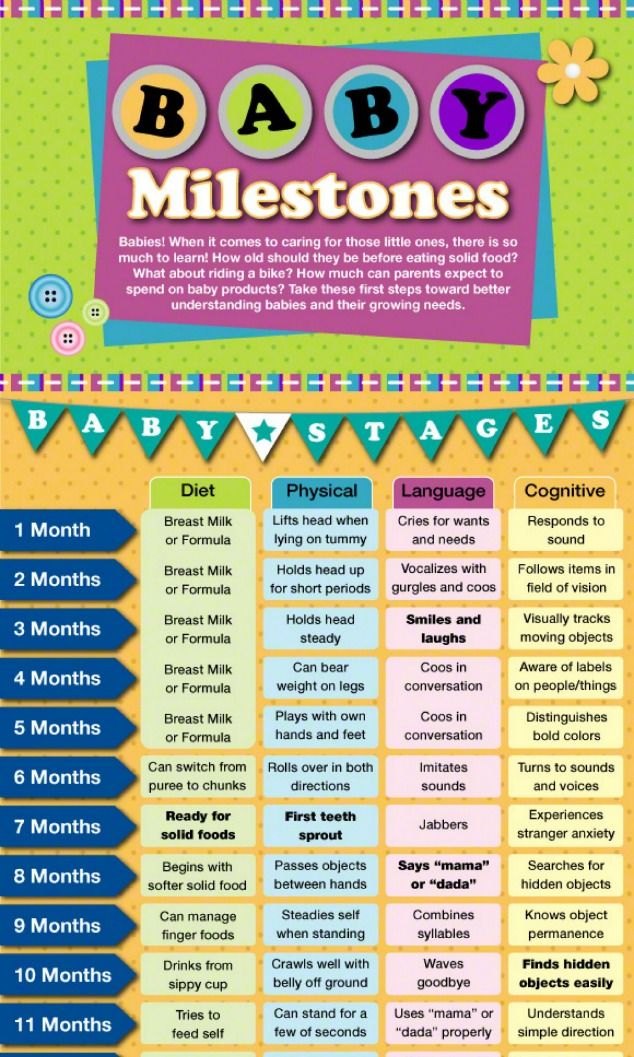 This technique is effective not only for naming objects, but also for verbally denoting actions performed with them.
This technique is effective not only for naming objects, but also for verbally denoting actions performed with them.
Distribution.
Continue and complete everything the baby says, but do not force him to repeat - it is enough that he hears you. For example:
Child: Soup.
Adult: "Vegetable soup is delicious", "The soup is eaten with a spoon"
By answering the child with common sentences using more complex language forms and rich vocabulary, you gradually lead him to complete his thought, and, accordingly, prepare the ground for mastering contextual speech.
Sentences.
The use of game songs, nursery rhymes, sentences in joint activities with kids gives them great joy. Accompanying the actions of the child with words contributes to the involuntary learning of his ability to listen to the sounds of speech, to catch its rhythm, individual sound combinations and gradually penetrate into their meaning. Having learned to distinguish the variability of amusing sound combinations, children, imitating adults, begin to play with words, sounds, phrases, capturing the specifics of the sound of their native speech, its expressiveness, imagery. Most of the works of oral folk art were created with the aim of developing the motor activity of the baby, which is closely connected with the formation of speech activity. The more small and complex finger movements a child performs, the more parts of the brain are included in the work, because it is directly connected with the hands, or rather, crosswise: with the right hand - the left hemisphere, and with the left - the right. It is important to satisfy the baby's need for emotional and tactile (touching, stroking) contact with adults. Most children are kinesthetic by nature: they love to be petted, cuddled, held hands. Oral folk art just contributes to the saturation of the need for affection, for physical contact.
Most of the works of oral folk art were created with the aim of developing the motor activity of the baby, which is closely connected with the formation of speech activity. The more small and complex finger movements a child performs, the more parts of the brain are included in the work, because it is directly connected with the hands, or rather, crosswise: with the right hand - the left hemisphere, and with the left - the right. It is important to satisfy the baby's need for emotional and tactile (touching, stroking) contact with adults. Most children are kinesthetic by nature: they love to be petted, cuddled, held hands. Oral folk art just contributes to the saturation of the need for affection, for physical contact.
Select.
Give your child a choice. The formation of responsibility begins from the moment when the baby is allowed to play an active role in what concerns him personally. The implementation of the possibility of choice gives the child a sense of self-importance and self-worth. By the age of two, the baby can make his own choice if this right is granted to him by adults: “Would you like to pour half a glass of milk or a whole glass?”, “Would you like a whole apple or half?”, “Do you want to play with a doll or a teddy bear?”
By the age of two, the baby can make his own choice if this right is granted to him by adults: “Would you like to pour half a glass of milk or a whole glass?”, “Would you like a whole apple or half?”, “Do you want to play with a doll or a teddy bear?”
Games with natural materials.
A huge influence on the growth of a child’s speech and cognitive activity is exerted by the variety and availability of objects that he can explore from time to time: look at them, taste them, manipulate, experiment, make small discoveries about them and with them. In its instinctive striving for self-development, the child, already in the first year of life, irresistibly rushes to sand, water, clay, wood and paper. There is a lot of meaning in “fussing” with them: the child is busy with work, he gets acquainted with the material, studies its properties, functions, etc. The most beloved and best toys are those that the child created himself: fortresses from sticks; ditches dug with an old spoon or scoop; paper boats; dolls made of rags, paper or straw.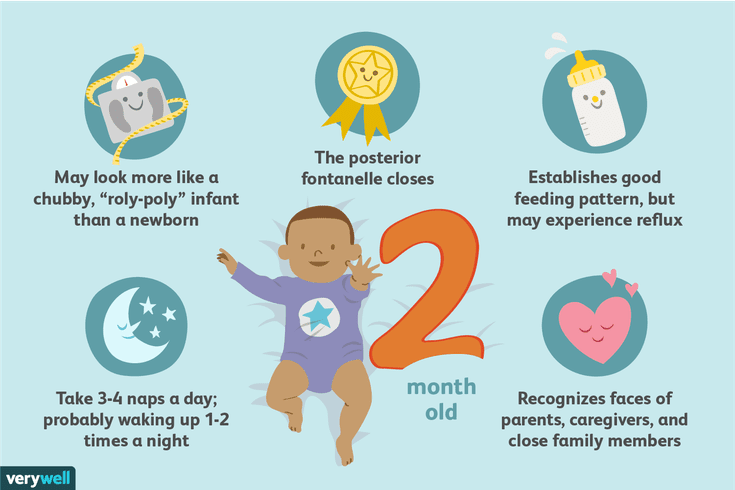
Productive activities.
At an early stage of speech development, the child masters the most diverse languages that replace words - gesticulation, facial expressions, onomatopoeia, elementary images. The word is for the child only one of the ways of expressing thoughts, but far from being the easiest. For many of his thoughts and ideas, he does not find suitable words, and expresses them in his own way, in other, more accessible ways: through productive activities. Drawing, modeling, application, design develop not only the child's linguistic abilities, but also sensory ones, which are of particular importance in the formation of mental activity. A person's thought becomes more definite and understandable if it is written down. A preschooler cannot and does not know how to write, and therefore he fixes his thoughts and ideas with the help of their sketches. So he fixes on paper all the ideas, feelings, thoughts, their combinations and intricacies that arose in his mind or soul during a certain period.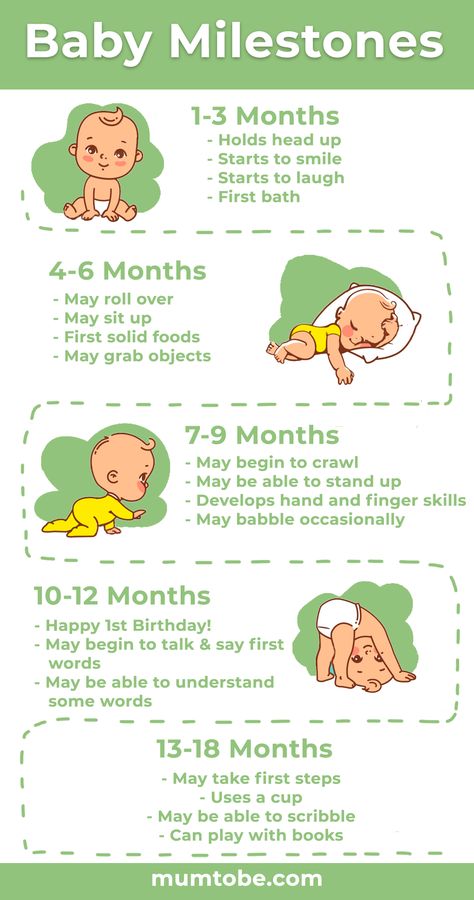 An adult, writing down his thoughts, has the opportunity to repeatedly return to work with them: read, “polish”, supplement and formulate to a truly conceptual meaning. The child is incapable of such conscious work: he has drawn and abandoned, his thought, his imagination has already gone in another direction. Putting a thought into a word in such a way that it becomes clear to others is one of the most important tasks of speech, communicative and mental development, where each specific drawing of a baby has an enduring and unique meaning. Try to turn any child's drawing into an interesting story, and the story into a drawing that you need to repeatedly return to, "read" and supplement. When there are enough such stories and drawings, you can sew them into a book and “read” them to your friends and relatives. A child who understands what he is saying, who combines a distinct idea with the spoken word, reliably masters his native language.
An adult, writing down his thoughts, has the opportunity to repeatedly return to work with them: read, “polish”, supplement and formulate to a truly conceptual meaning. The child is incapable of such conscious work: he has drawn and abandoned, his thought, his imagination has already gone in another direction. Putting a thought into a word in such a way that it becomes clear to others is one of the most important tasks of speech, communicative and mental development, where each specific drawing of a baby has an enduring and unique meaning. Try to turn any child's drawing into an interesting story, and the story into a drawing that you need to repeatedly return to, "read" and supplement. When there are enough such stories and drawings, you can sew them into a book and “read” them to your friends and relatives. A child who understands what he is saying, who combines a distinct idea with the spoken word, reliably masters his native language.
Replacement.
"Imagine that .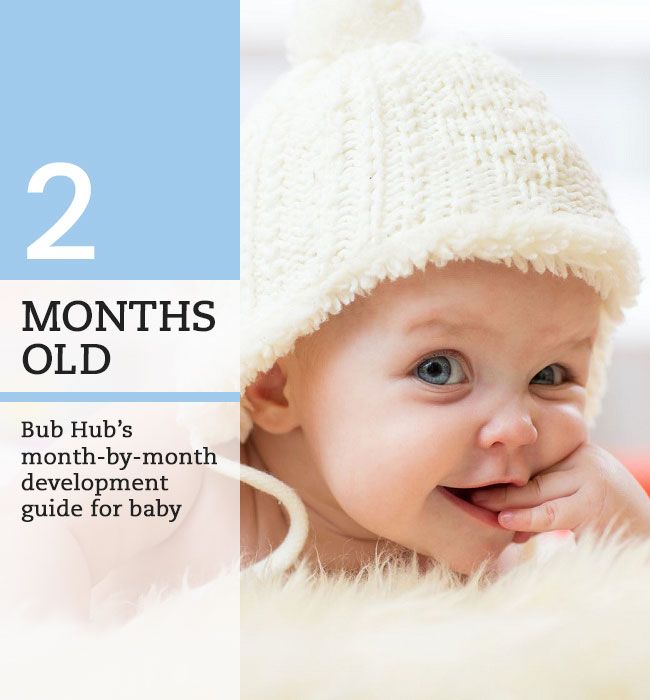 .." - these words are filled with a special attractive force for the child. At the age of two, the kid imagines with pleasure that the cube is a pie, and the shoe box is an oven. By the age of three, he is able to imagine himself as an airplane, a cat, a flower, etc. The words sound like a magic spell for a child: “Imagine that we are airplanes. Now we will fly around the whole room. Such an etude-game form develops the child's reflexive and empathic abilities, without which communication will not be full and developing. At this age, children also really like pantomime games, which activate the curiosity and observation of the baby. You can involve a child in such a game with the help of a sentence question: "Guess what I'm doing now." It is preferable to start with elementary actions: comb your hair, brush your teeth, eat an apple, pour milk, read a book. After the child has guessed, invite him to think of an action for you, and then “revive” the situation you set: set the table; walk on warm sand; run away like a fox carrying off a rooster; walk like daddy bear and son-bear cub, etc.
.." - these words are filled with a special attractive force for the child. At the age of two, the kid imagines with pleasure that the cube is a pie, and the shoe box is an oven. By the age of three, he is able to imagine himself as an airplane, a cat, a flower, etc. The words sound like a magic spell for a child: “Imagine that we are airplanes. Now we will fly around the whole room. Such an etude-game form develops the child's reflexive and empathic abilities, without which communication will not be full and developing. At this age, children also really like pantomime games, which activate the curiosity and observation of the baby. You can involve a child in such a game with the help of a sentence question: "Guess what I'm doing now." It is preferable to start with elementary actions: comb your hair, brush your teeth, eat an apple, pour milk, read a book. After the child has guessed, invite him to think of an action for you, and then “revive” the situation you set: set the table; walk on warm sand; run away like a fox carrying off a rooster; walk like daddy bear and son-bear cub, etc.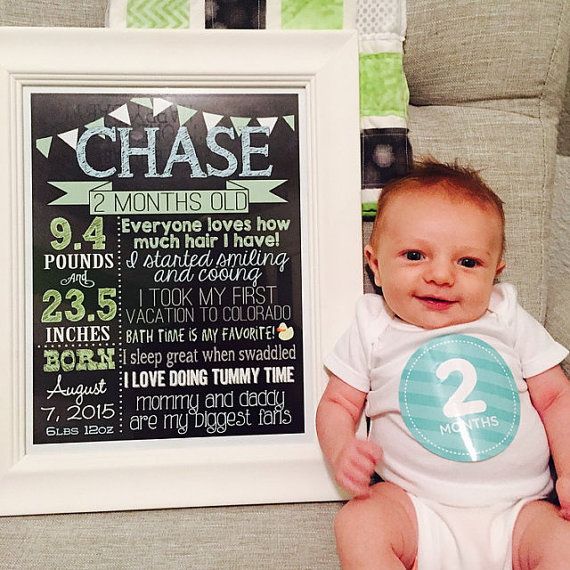 Pantomime games and imitation games are the first step in theatrical and role-playing games.
Pantomime games and imitation games are the first step in theatrical and role-playing games.
Role play.
This type of children's activity at a young age is only being formed, and it acquires the fullness of the development that leads to it somewhat later. But this does not mean at all that there is no need to organize elementary plot-role-playing actions during this period. With some ingenuity, adults may well organize role-playing games. For example, playing on the phone, when a child, using a toy device, can call mom, dad, grandmother, fairy-tale characters. Playing on the phone stimulates the child's speech development, builds self-confidence, and increases communicative competence. Encourage children's tendency to imitate - this develops attention to detail, awareness of the direct and figurative meaning of words.
Music games. The importance of musical games in the speech development of a child can hardly be overestimated.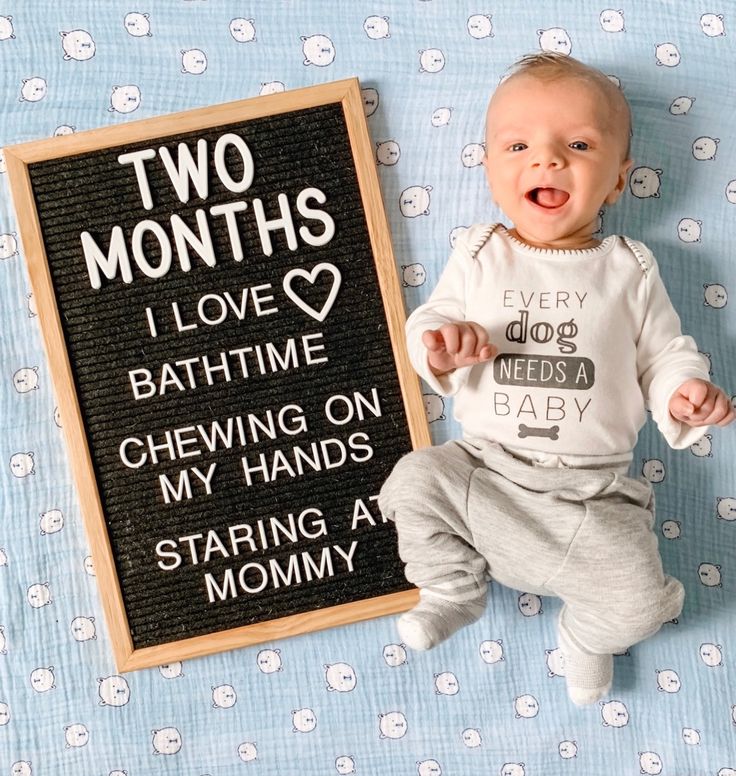 Kids sing along with pleasure, adore noise musical instruments, ritual games such as "Loaf", "Over the bumps", "The woman sowed peas", etc. Encourage the child's desire to move to the music, sing along. It's okay that the child first pronounces only the endings or the last words of the song lines. Subsequently, he will begin to sing small songs in their entirety and, possibly, distort some of the words. This should not scare you - sing the song along with the "main performer", but, unlike him, sing it correctly. More often give the baby the opportunity to move to a variety of music, independently extract sounds from various objects, accompanying himself. A child dances and sings about what he sees around, hears, invents his own songs and melodies - this is how a creator is born!
Kids sing along with pleasure, adore noise musical instruments, ritual games such as "Loaf", "Over the bumps", "The woman sowed peas", etc. Encourage the child's desire to move to the music, sing along. It's okay that the child first pronounces only the endings or the last words of the song lines. Subsequently, he will begin to sing small songs in their entirety and, possibly, distort some of the words. This should not scare you - sing the song along with the "main performer", but, unlike him, sing it correctly. More often give the baby the opportunity to move to a variety of music, independently extract sounds from various objects, accompanying himself. A child dances and sings about what he sees around, hears, invents his own songs and melodies - this is how a creator is born!
Source:
www.r-rech.ru
MedEncyclopedia - MedPortal.ru
Inessa Smyk, Daria Golubeva
What is child development and what skills do children develop at different ages
What is child development?
Child development is a process that every child goes through.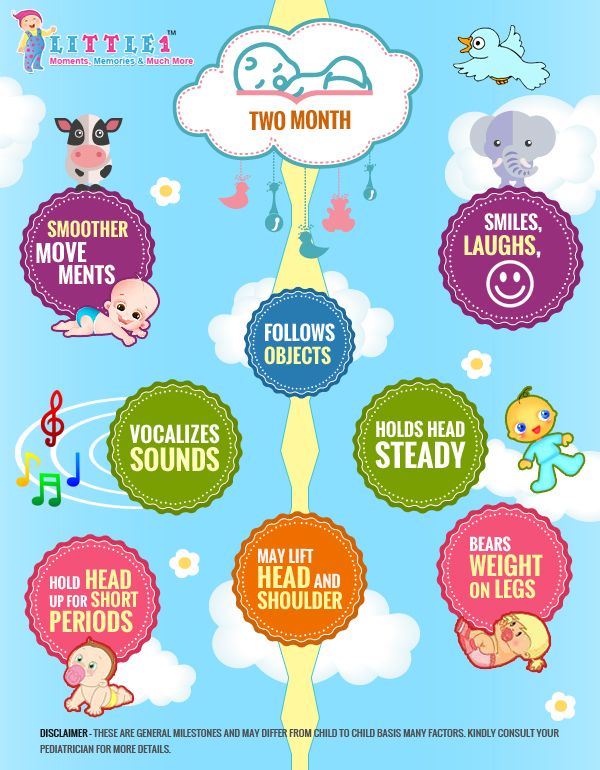 This process includes learning and mastering skills such as sitting, walking, talking, jumping, and tying shoes. Children learn these skills, called developmental milestones, in predictable periods of time.
This process includes learning and mastering skills such as sitting, walking, talking, jumping, and tying shoes. Children learn these skills, called developmental milestones, in predictable periods of time.
Children develop skills in five main areas of development:
- Cognitive development
This is the child's ability to learn and solve problems. For example, this applies to a two-month-old child who is learning to explore the environment with his hands or eyes, or a five-year-old child who is learning to solve simple mathematical problems. - Social and emotional development.
This is the child's ability to interact with others, including self-help and self-control. Examples of this type of development include: a six-week-old smiling baby, a ten-month-old waving goodbye, or a five-year-old boy who can take turns playing school games. - Speech and language development
This is the child's ability to understand and use language. For example, this includes a 12-month-old child speaking their first words, a two-year-old child naming parts of their body, or a five-year-old child learning to say "feet" instead of "feet.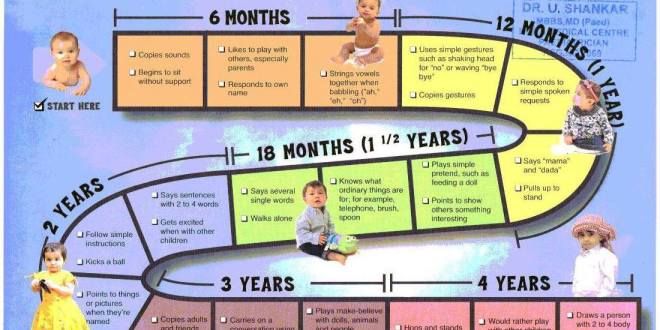 "
" - Fine motor development This is the child's ability to use small muscles, particularly hands and fingers, to pick up small objects, hold a spoon, turn pages in a book, or draw with chalk.
- Gross motor development
This is the child's ability to use large muscles. For example, a six-month-old child learns to sit with some support, a 12-month-old child learns to pull himself up to a stand by holding on to furniture, and a five-year-old child learns to jump.
The National Center for Birth Defects and Malformations recently launched a campaign to promote child development.
What is a milestone?
A milestone is a skill that a child acquires over a period of time. For example, one of the milestones in development is learning to walk. Most children master this skill or developmental stage between 7 and 15 months of age.
Milestones progress in sequence. This means that the child needs to develop some skills before he or she can develop new skills.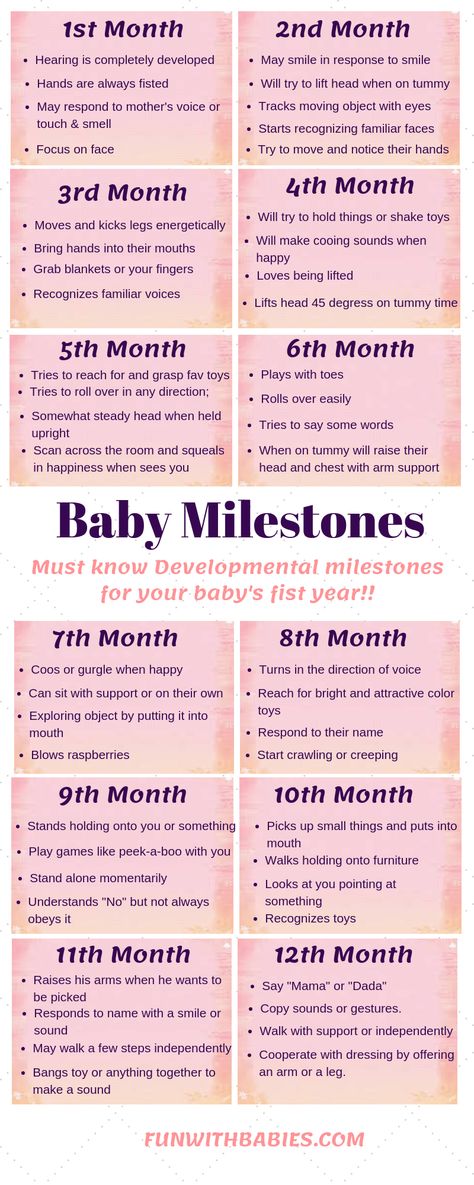 For example, babies must first learn to crawl and get into a standing position before they can walk. Each milestone a child receives builds on the last milestone reached.
For example, babies must first learn to crawl and get into a standing position before they can walk. Each milestone a child receives builds on the last milestone reached.
To learn more about age-appropriate developmental milestones, click on a specific age below. If you are concerned that your child has not reached a developmental milestone.
What are the typical milestones or skills that children learn at different ages?
We now know that our brains are not fully developed at birth. In fact, a child's brain weighs about a quarter (1/4) that of an adult brain!
The brain grows very rapidly during the first few years of life. During this time, your child learns all sorts of new skills.
Because children typically acquire milestones or skills over a period of time or "window", we can predict when most children will learn different skills. The pages below describe the types of skills children typically acquire at different ages. If you are concerned that your child has not reached a developmental milestone, click here to learn more.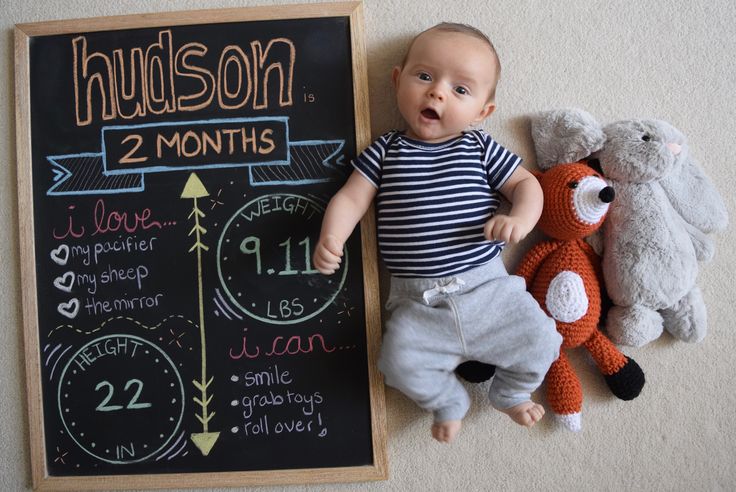
Child development:
- First 6 weeks
- 1.5 to 3 months
- 3 to 6 months
- 6 to 9 months
- 9 to 12 months
- 1 to 2 years
- 2 to 3 years
- 3 to 5 years
- 5-7 years
What if my child is not reaching a developmental milestone?
Every child is different and may reach developmental milestones a little earlier or later than their peers. You may have heard people say things like "he walked before he was 10 months old, much earlier than his older brother" or "she didn't talk much until she was 2 and then she spoke blue strip!" This is because every child is unique and will develop at their own pace.
However, there are definitely times when most children reach a certain milestone. For example, children learn to walk at any time between the ages of 9 and 15 months. So, if your baby is 13 months old and not yet walking, there is no need to worry if he crawls and reaches for the bar.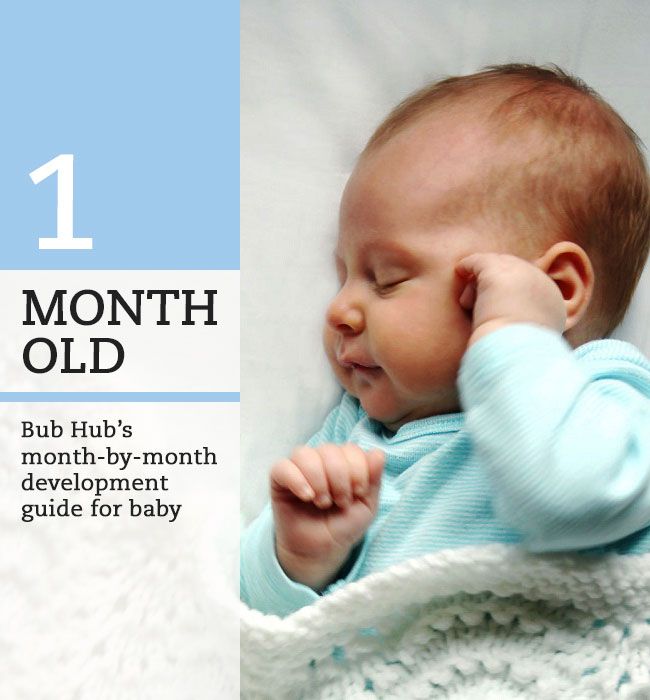 He has acquired the skills necessary to learn to walk and may soon be able to walk. However, if you have a child at 15 months of age who is not yet walking, it would be a good idea to talk to your child's pediatrician to make sure there are no health or developmental issues, as 15 months of age is out of the norm. "window" or time frame in which children learn to walk.
He has acquired the skills necessary to learn to walk and may soon be able to walk. However, if you have a child at 15 months of age who is not yet walking, it would be a good idea to talk to your child's pediatrician to make sure there are no health or developmental issues, as 15 months of age is out of the norm. "window" or time frame in which children learn to walk.
On this website, we will provide you with some information about these "windows", or periods of time when children usually develop a skill. We will also share with you some warning signs or "red flags" to look out for as it could mean that your child is not reaching milestones. We will also give you the titles of some books and websites about child development that you might find useful.
However, if you have questions, do not hesitate to contact a professional such as your child's doctor, nurse practitioner, or trained child development or behavioral specialist. There are also several clinical professionals who have specialized training in various areas of development who can be consulted, including speech and language pathologists, occupational and physical therapists, developmental psychologists, and audiologists.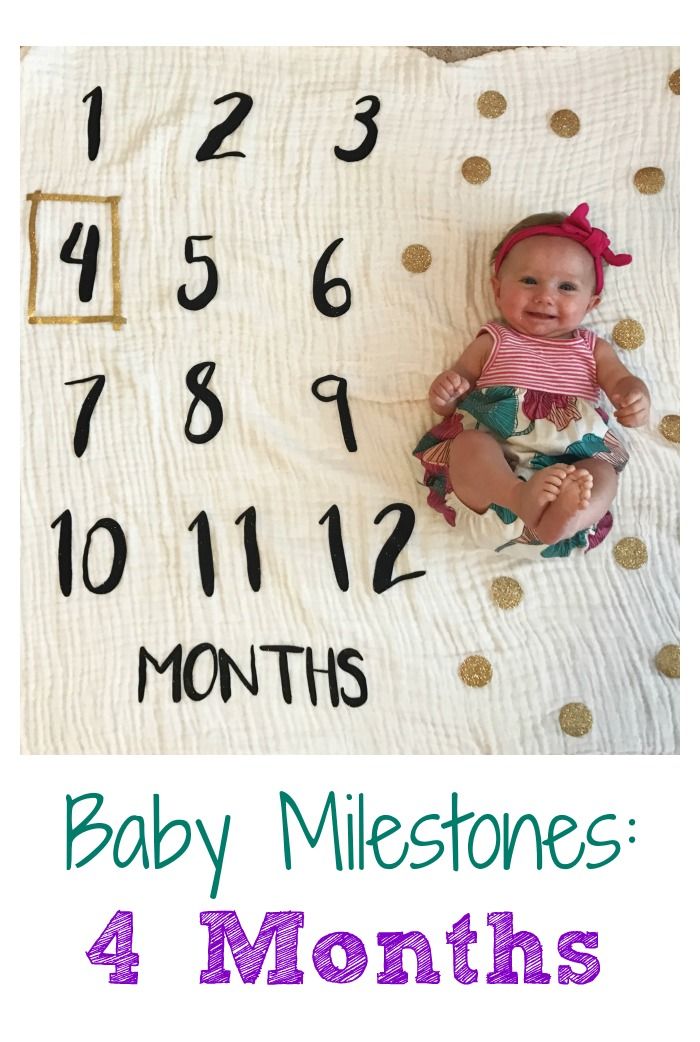
How can I help my child reach these developmental milestones?
As parents, we all want our children to succeed and be the best they can be. We know from research that two factors influence your child's success and growth: genes and environment.
One of the factors that influence our child's development is their genetic make-up or "genes". Some call it "nature". Genes are the genetic material that we pass on to our children. Children are born with their own "genes". These genes act as a blueprint for what characteristics a child might have. For example, genes determine whether a child will have blue or brown eyes; they also determine whether he is left-handed or right-handed.
Another factor that influences a child's development is the environment. This includes experiences children have at home, at school and in the community. Some people call it "nurturing". The environment can either improve or damage a child's genetic makeup. For example, malnourished children who live in third world countries may not reach their IQ potential due to environmental influences on their brain development.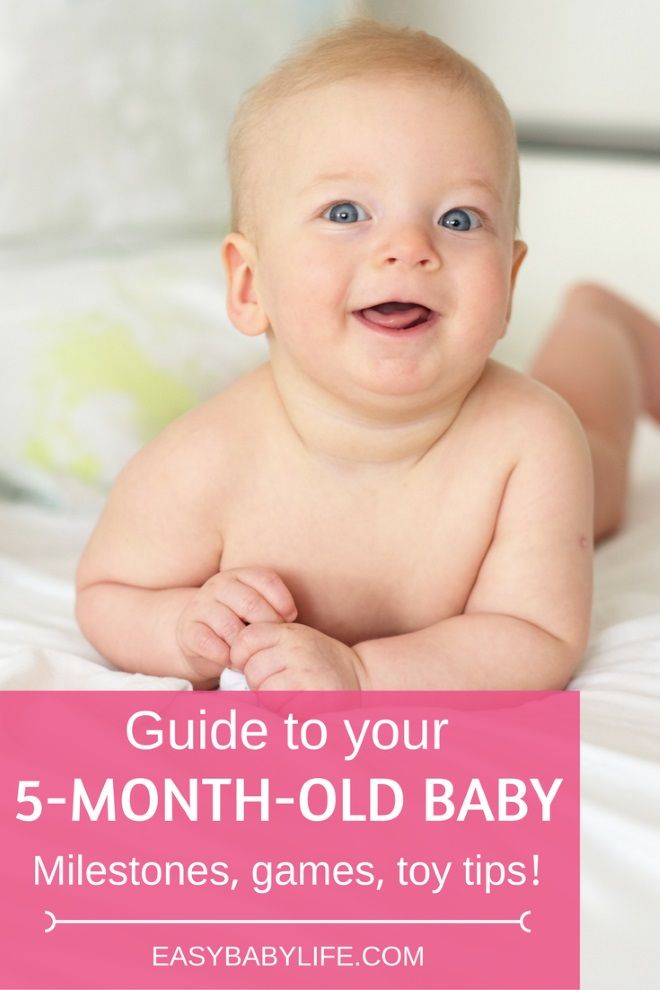
We often think that we need to run out and buy special toys, music, and games to stimulate our child's development, but we must remind ourselves that it is much more important to provide the following daily activities that you can do with your child to encourage development brain.
- Give your child lots of love and attention. Regardless of a child's age, holding, cuddling, and listening are important ways to show your child that they matter.
- Interact with your child by talking, drinking, playing, eating and reading with them. Your child will grow up feeling special and important to you. You will also learn a lot about your child's interests and abilities.
- Read read read. Studies have shown that children who are read by their parents have a larger vocabulary than other children. Reading also allows children to take a fresh look at the world we live in.
- Learn simple parenting skills to help your child learn to behave. The most important parenting skills are having consistent rules, rewarding behaviors that you want your child to do more of, and consequences for behaviors that you don't want your child to continue doing.

Learn more
